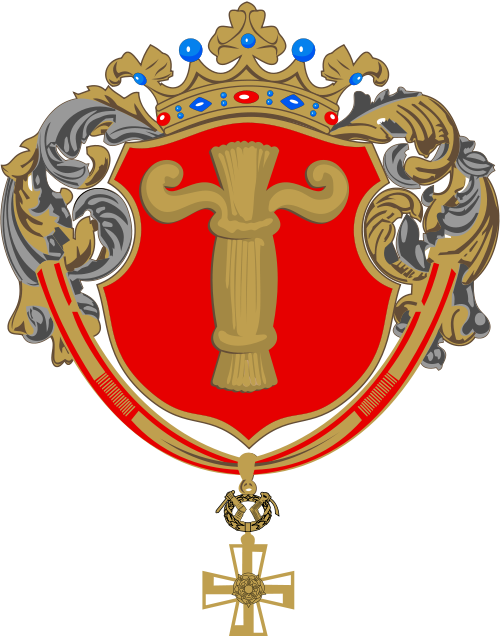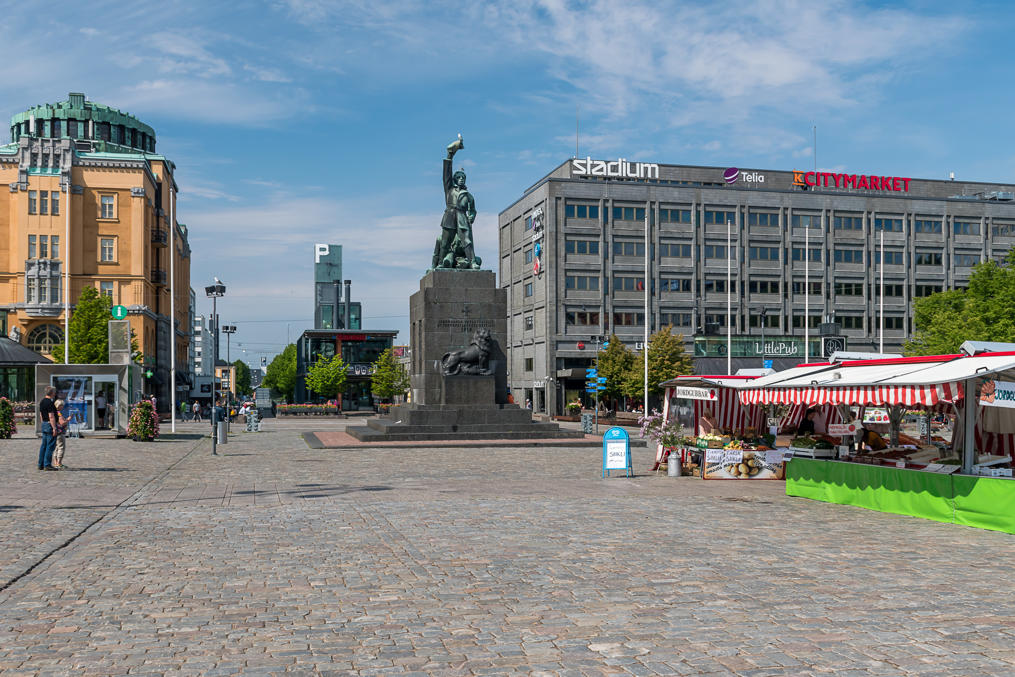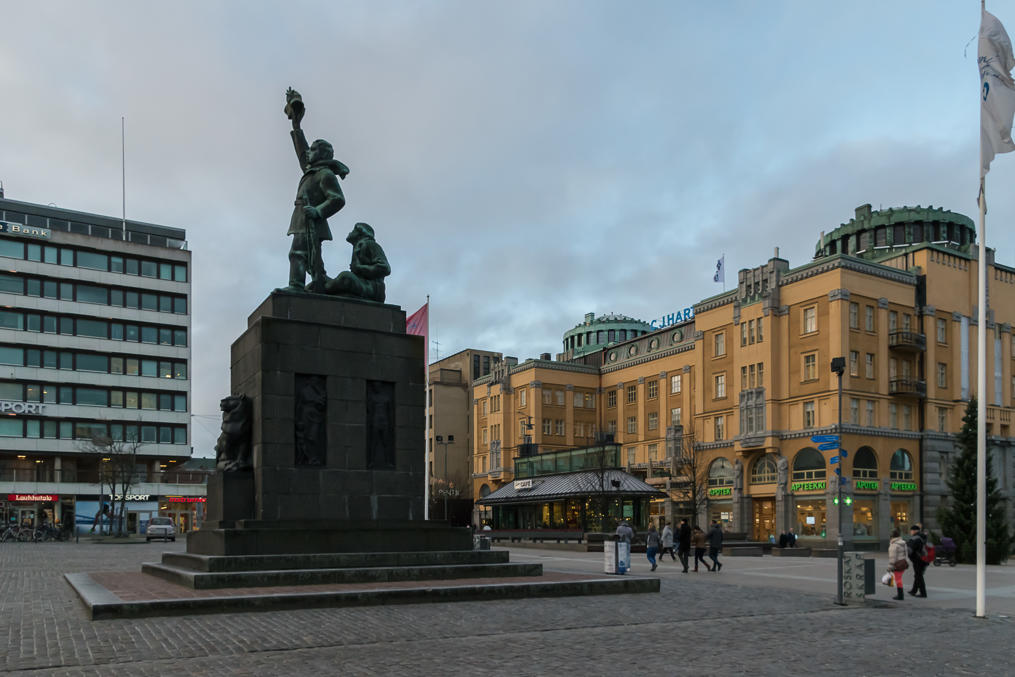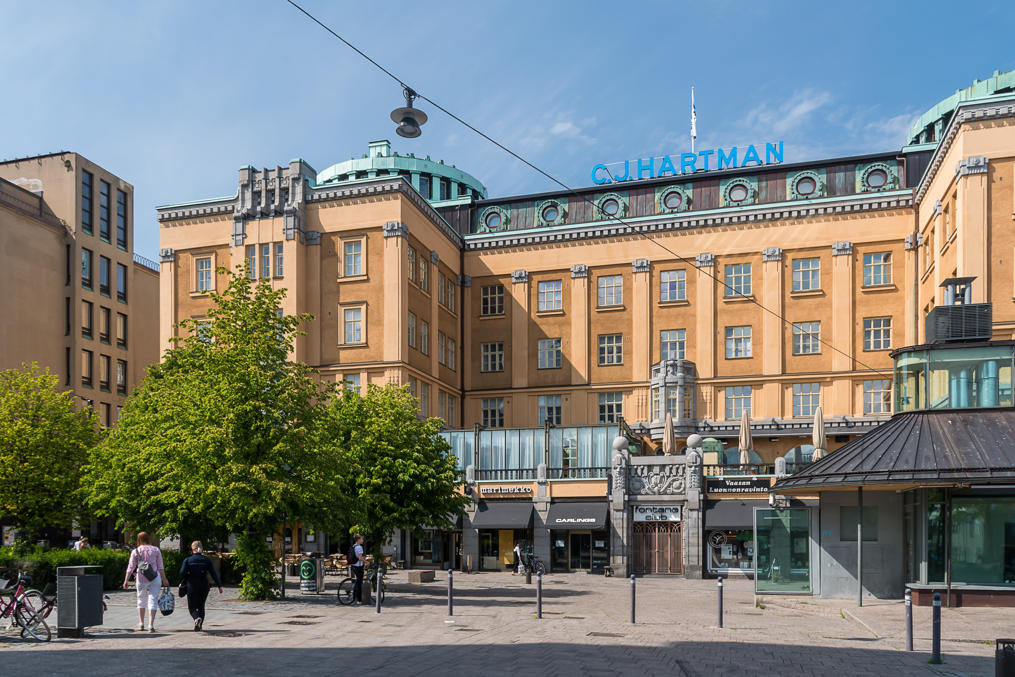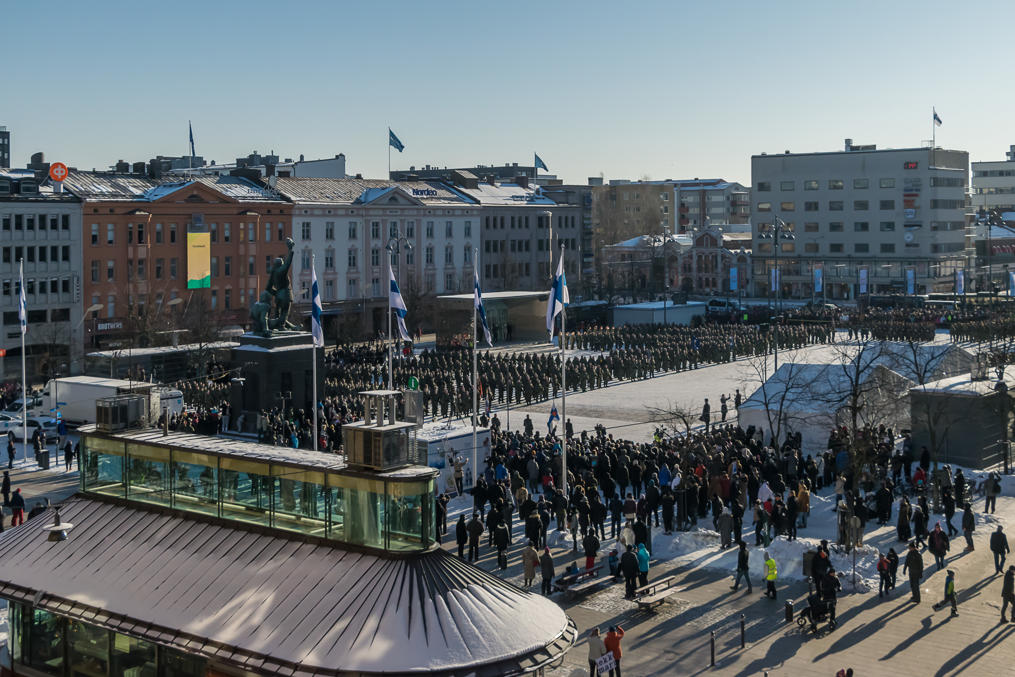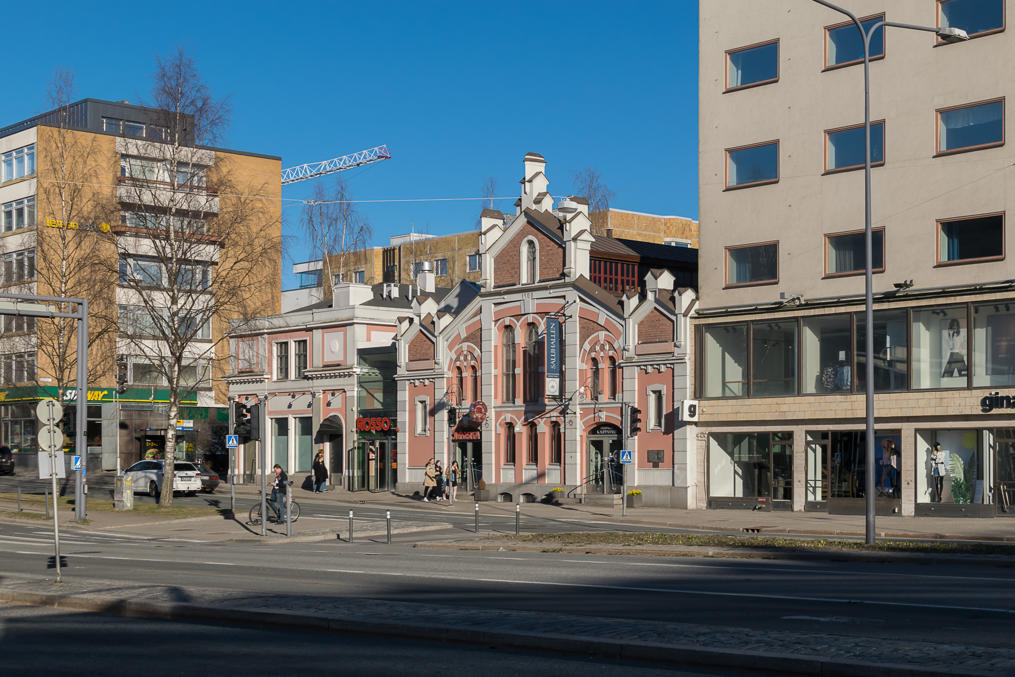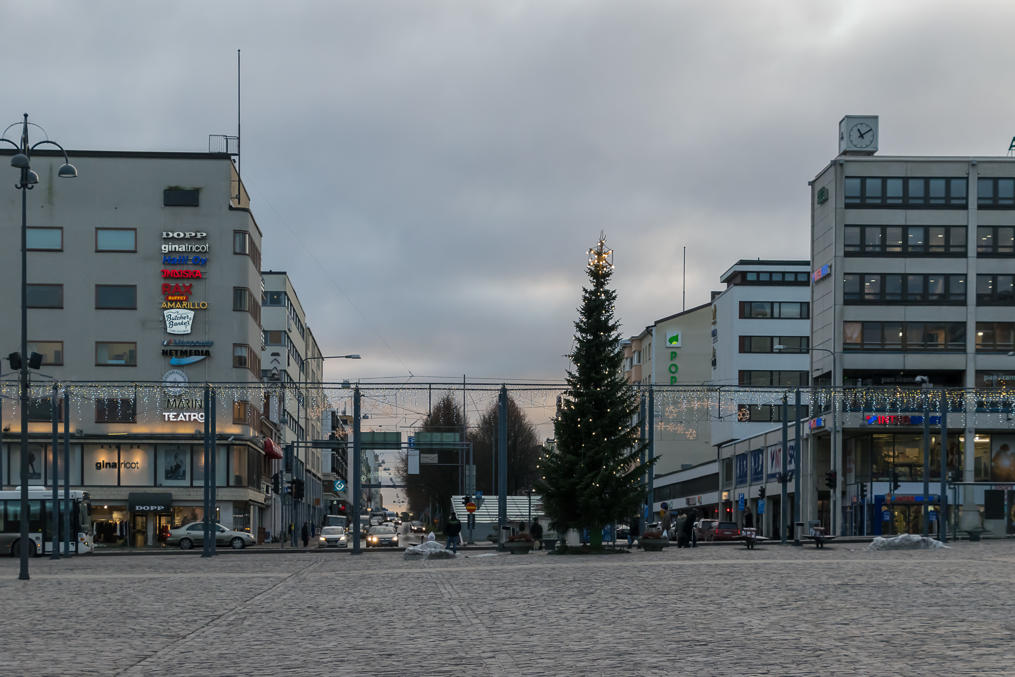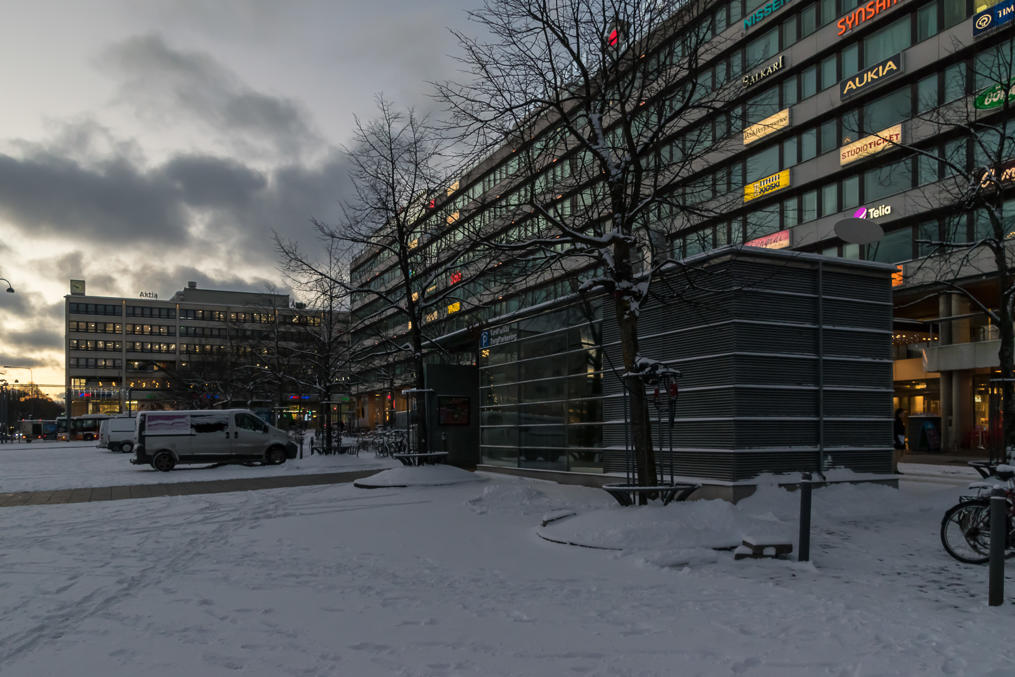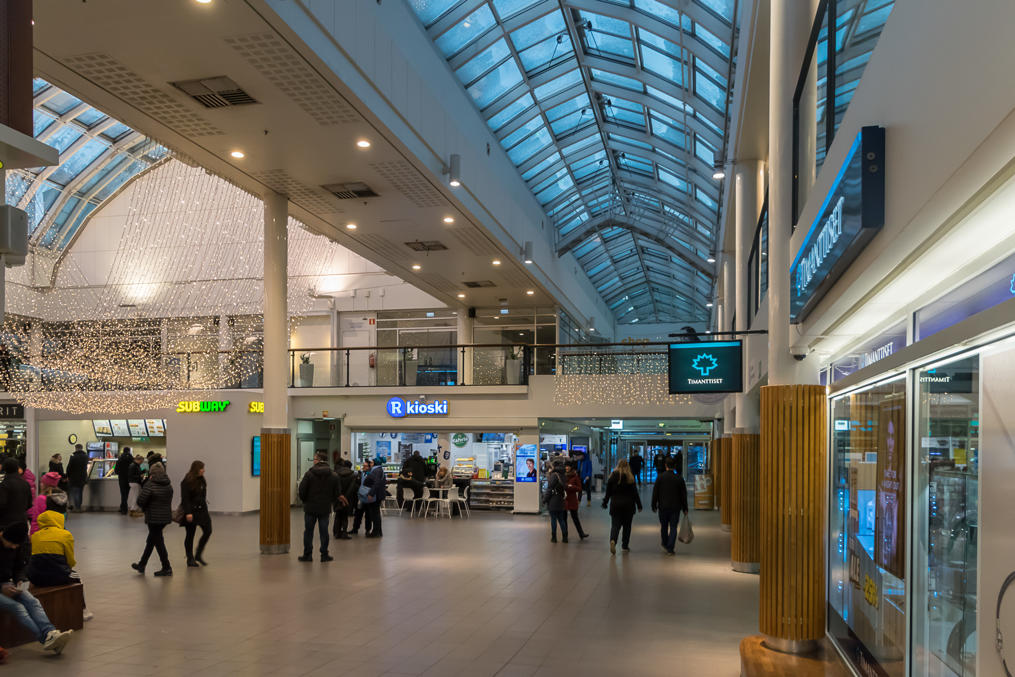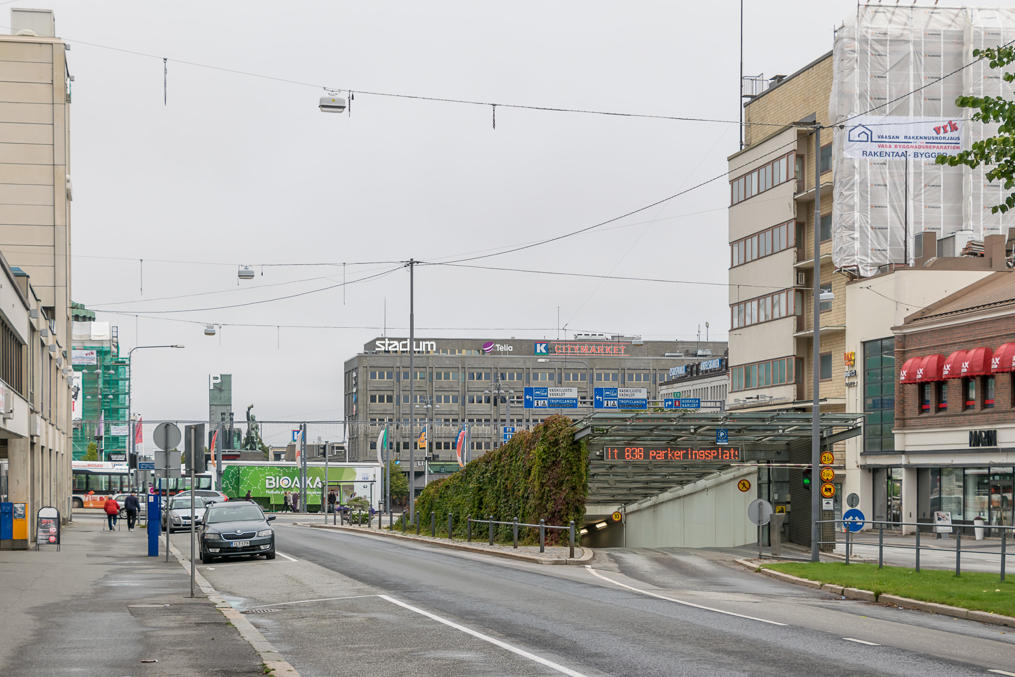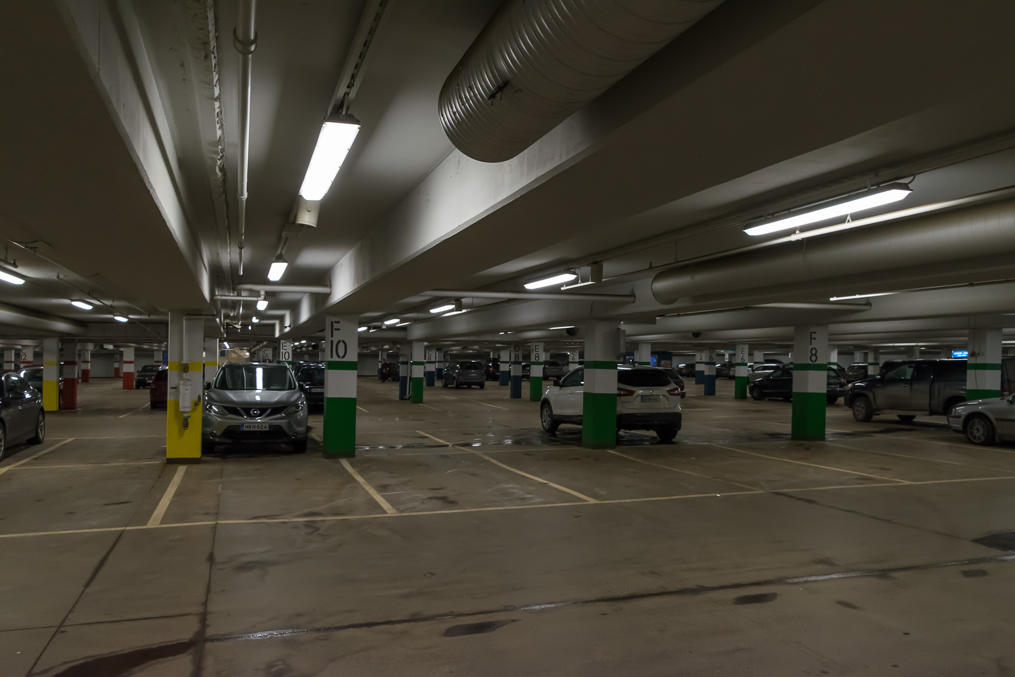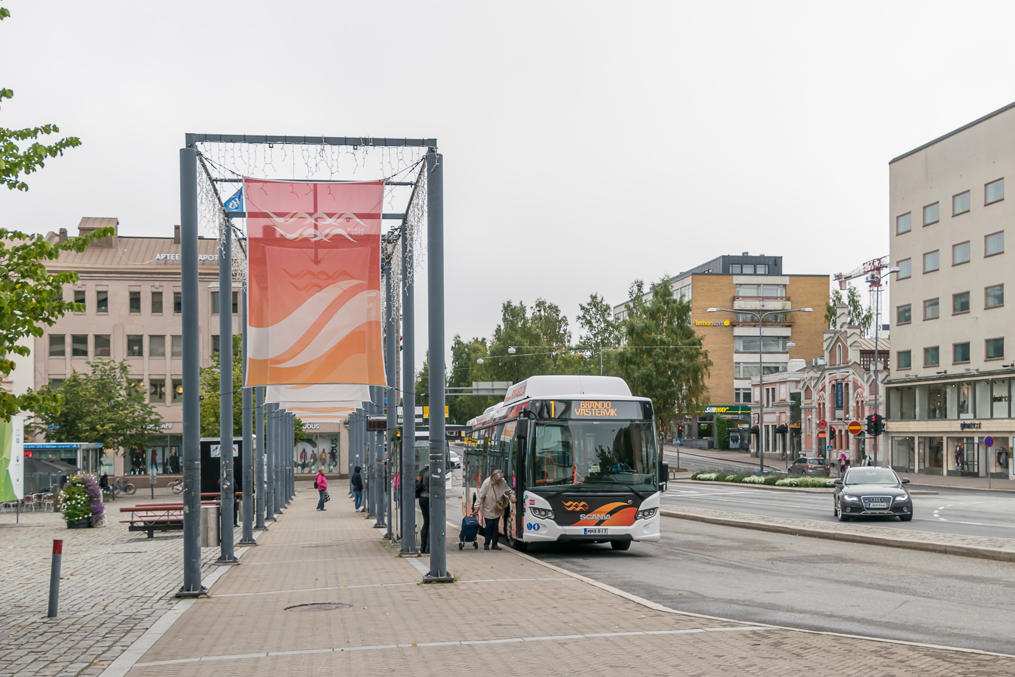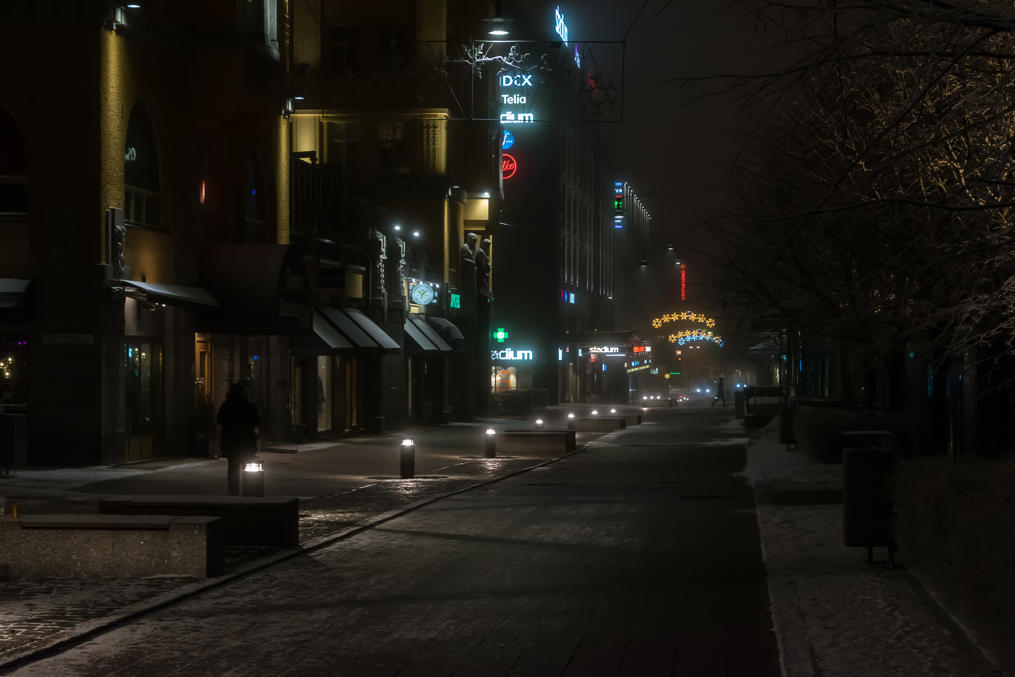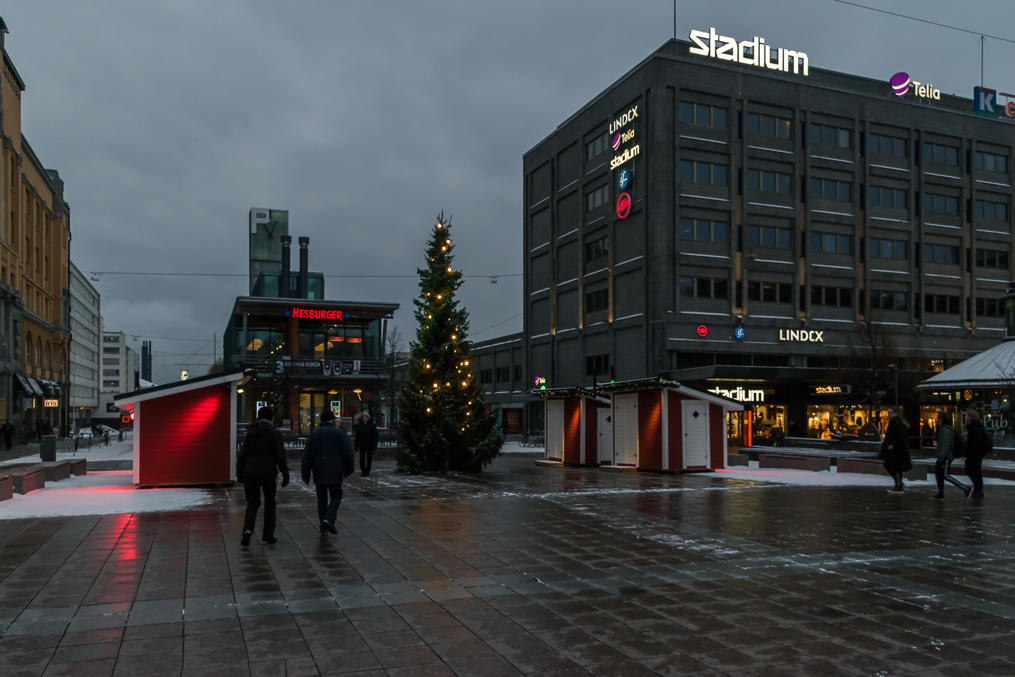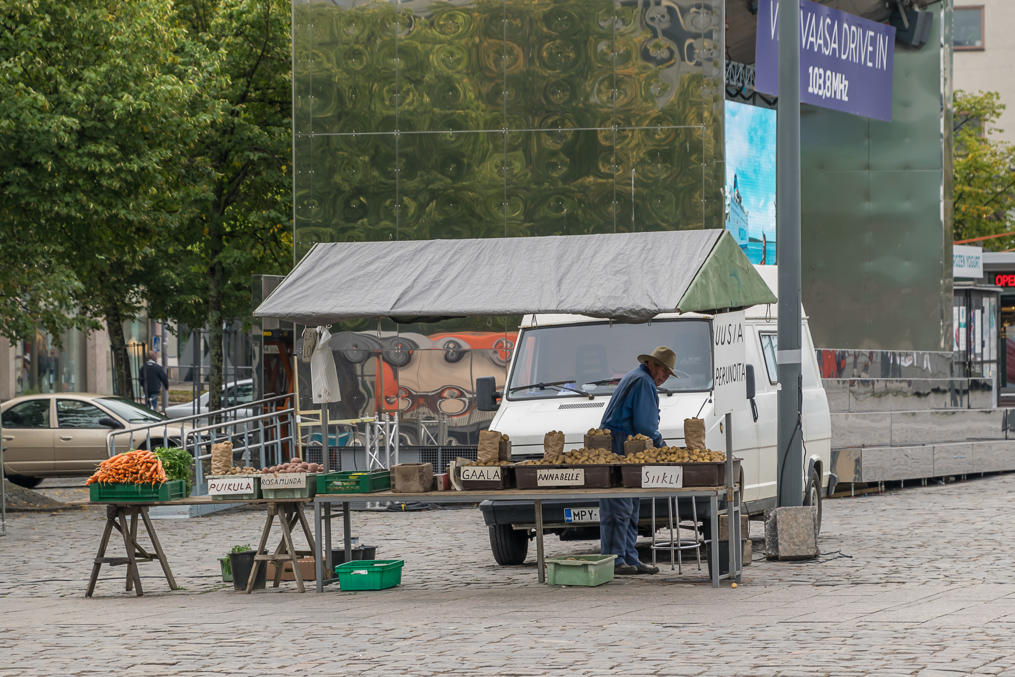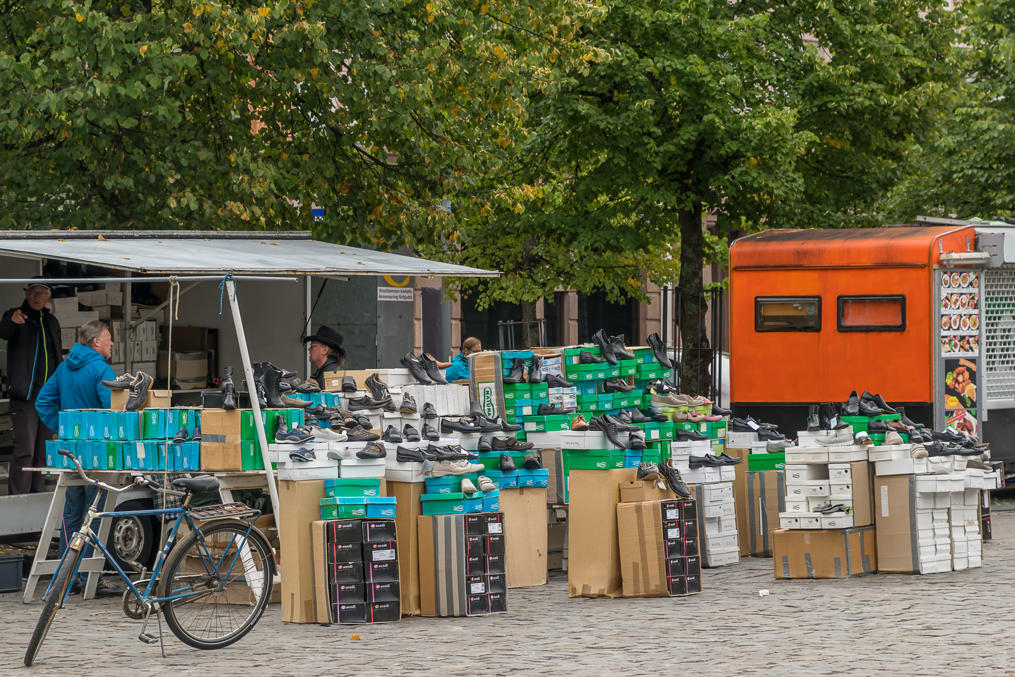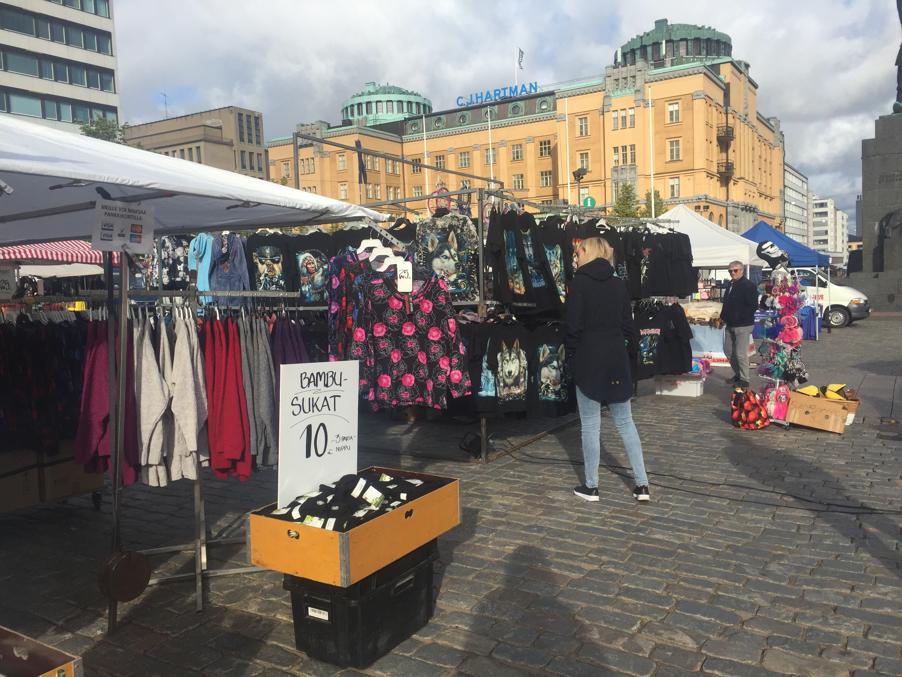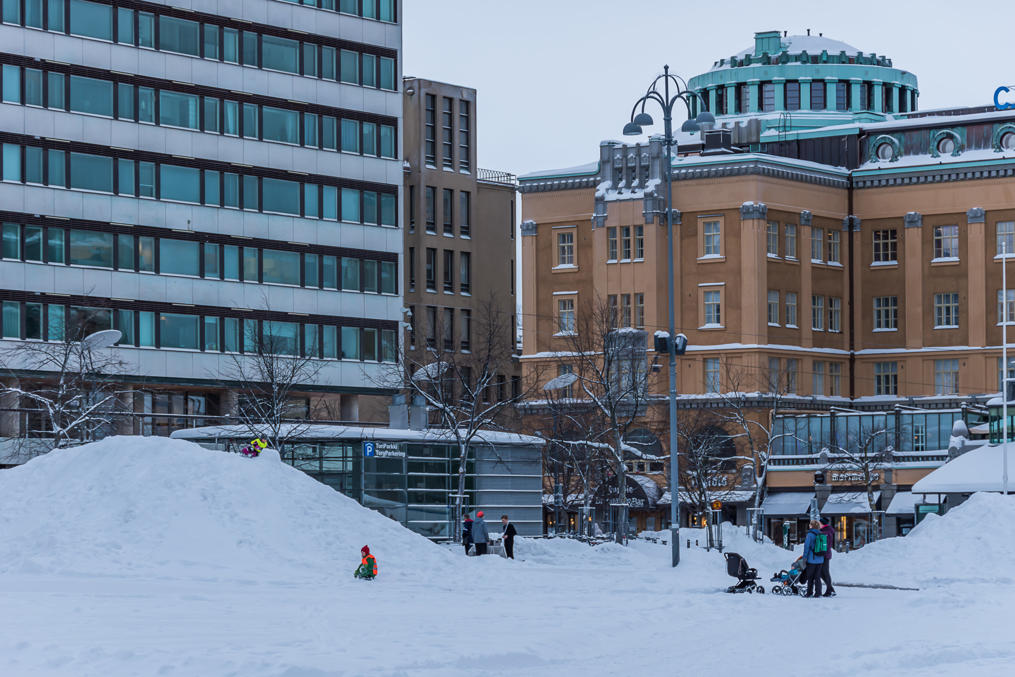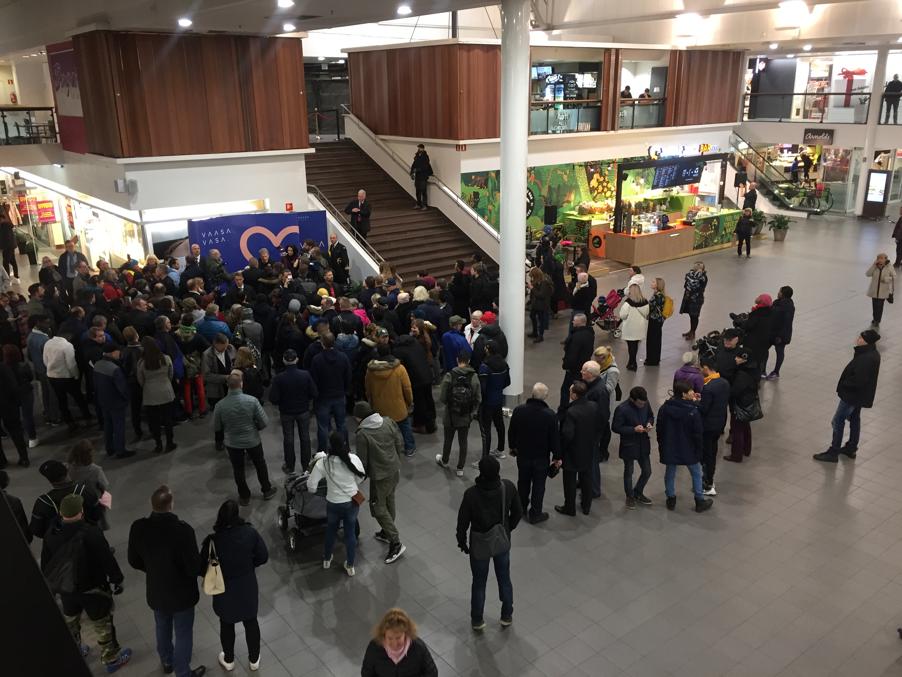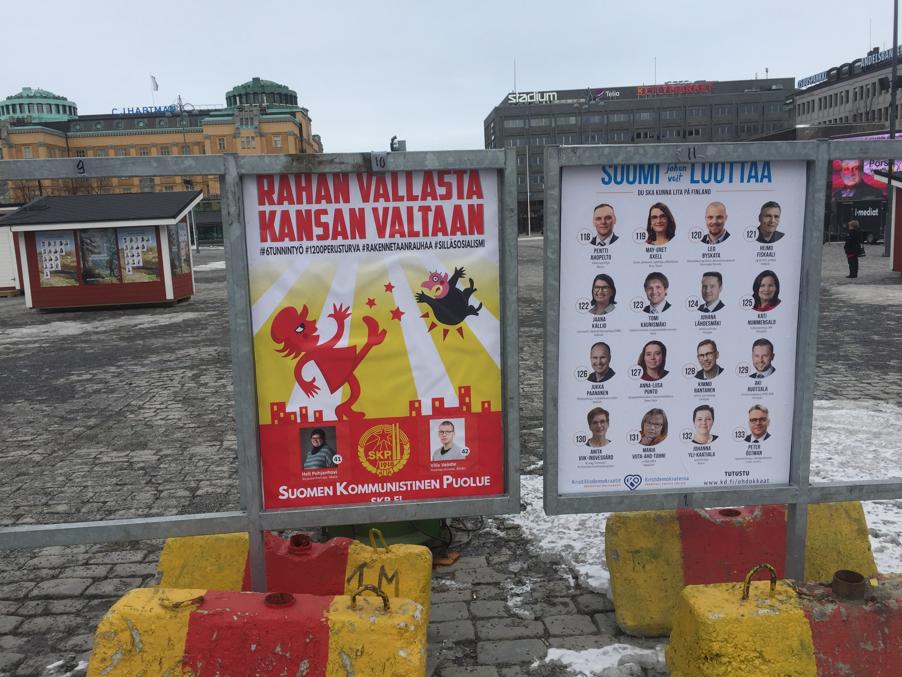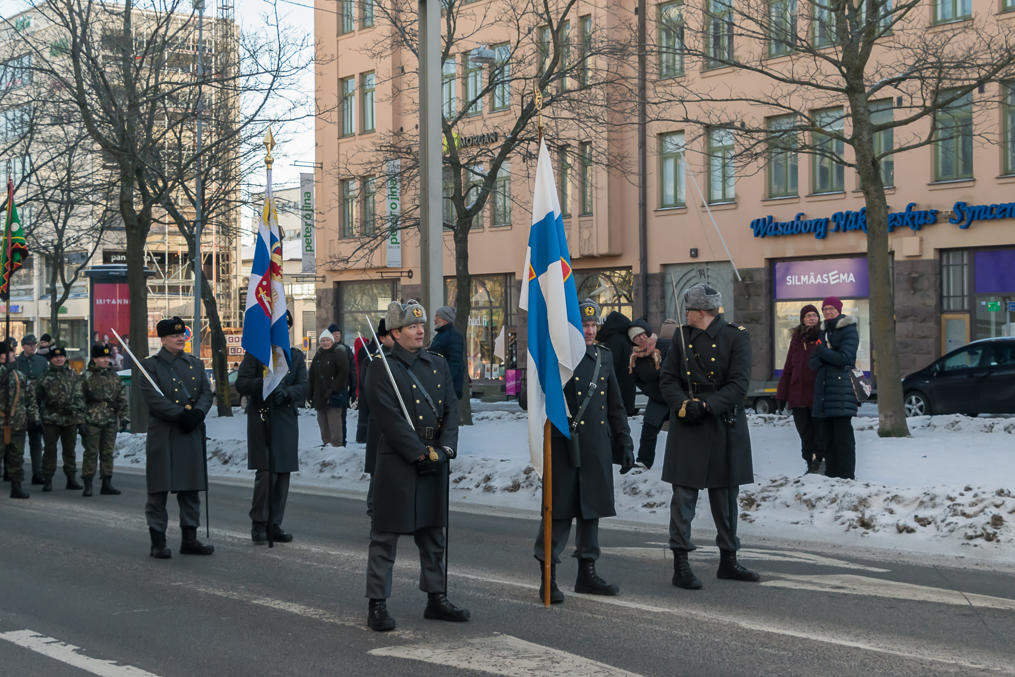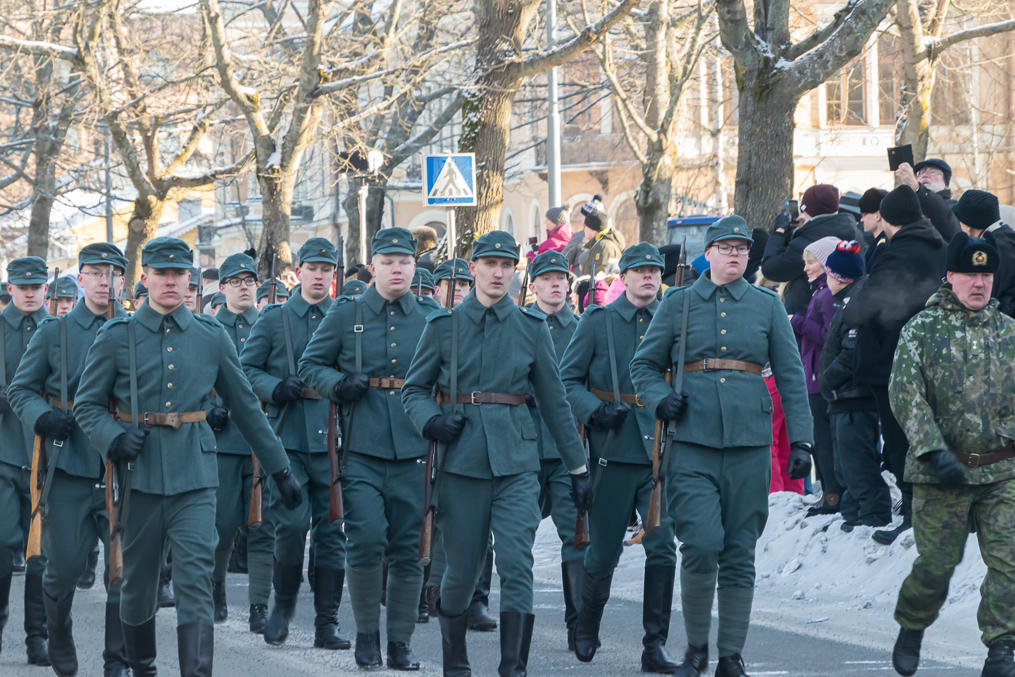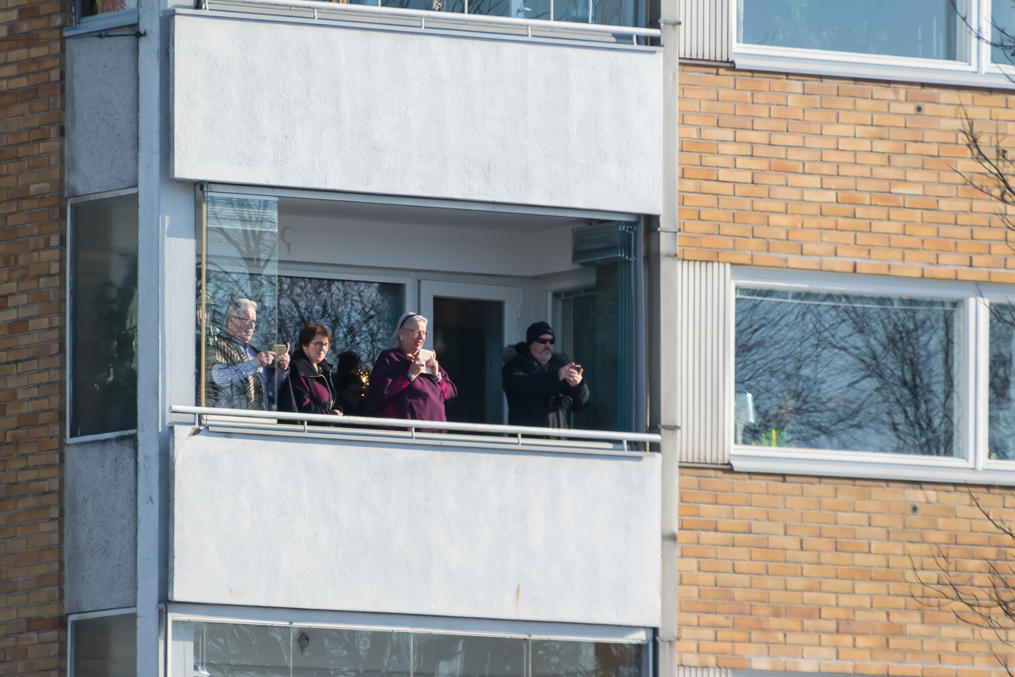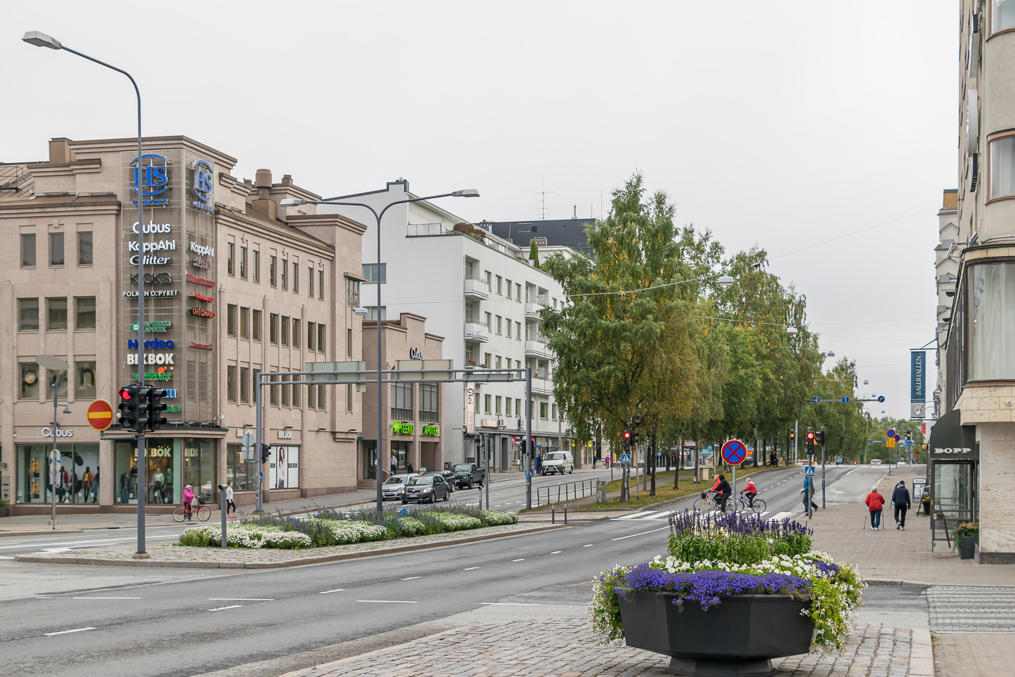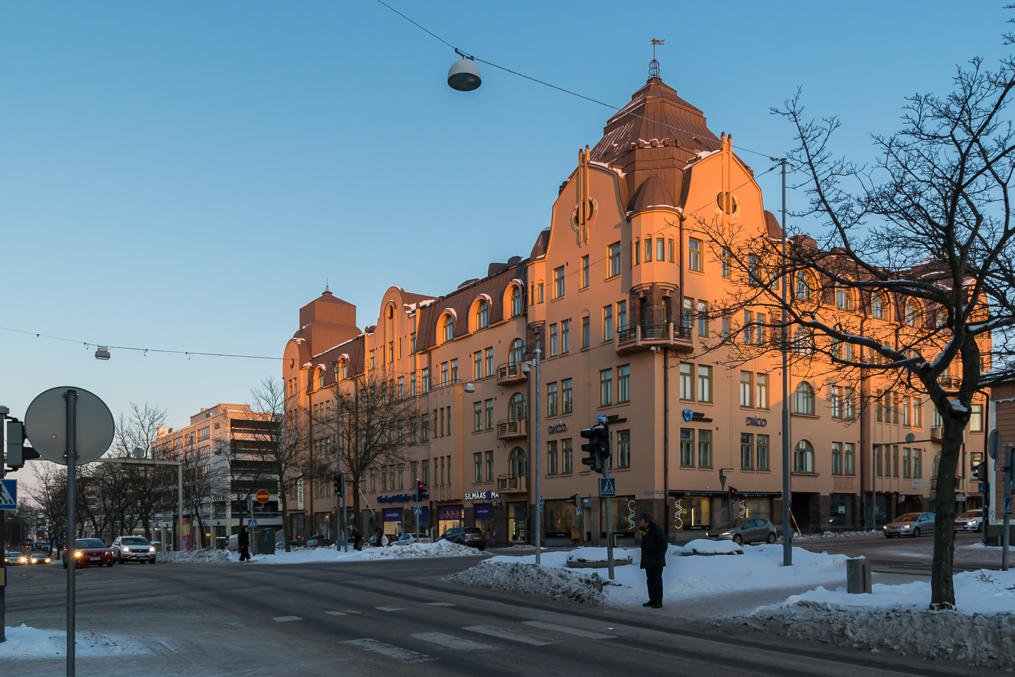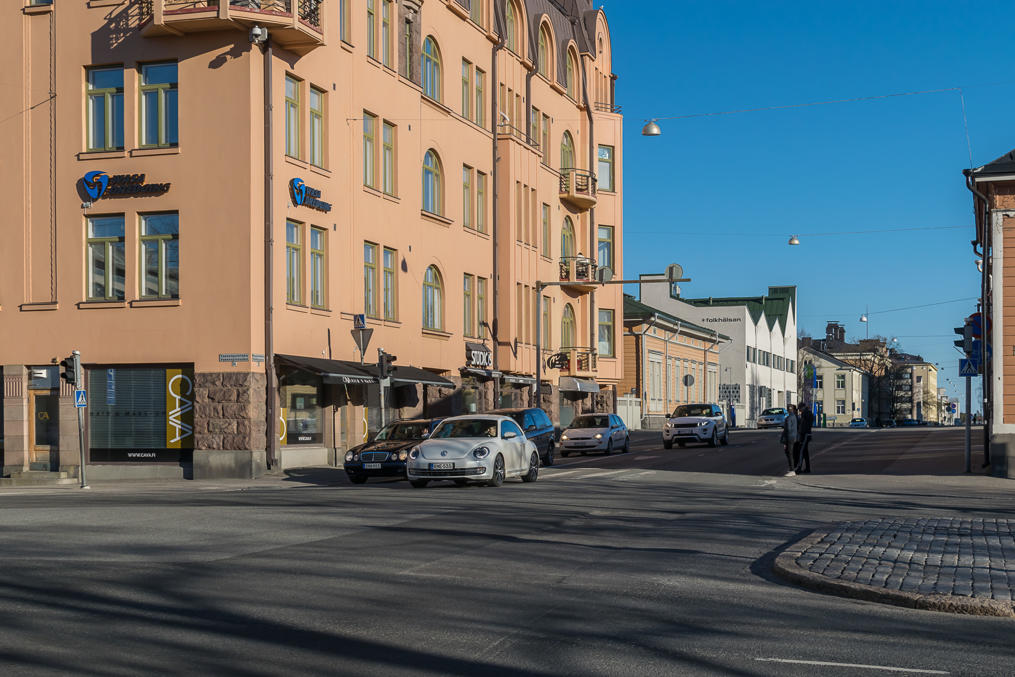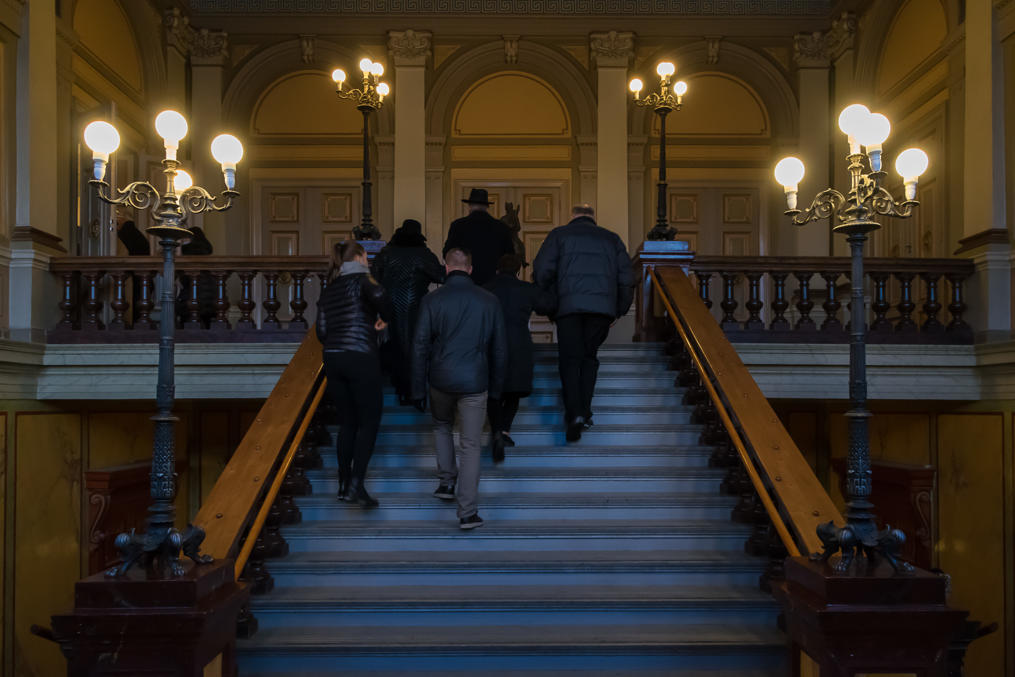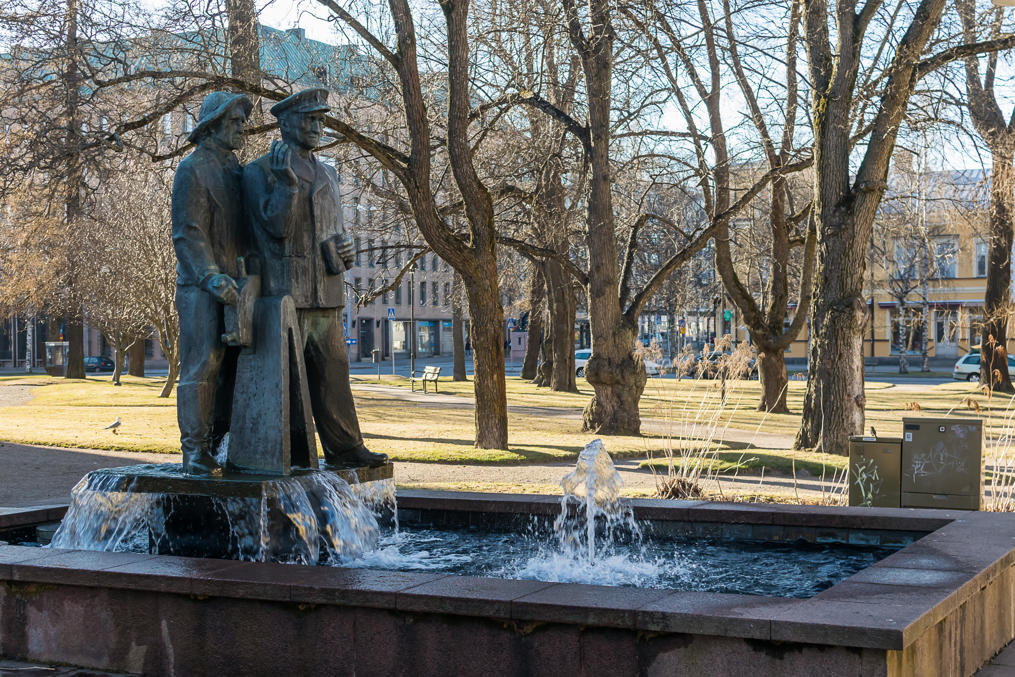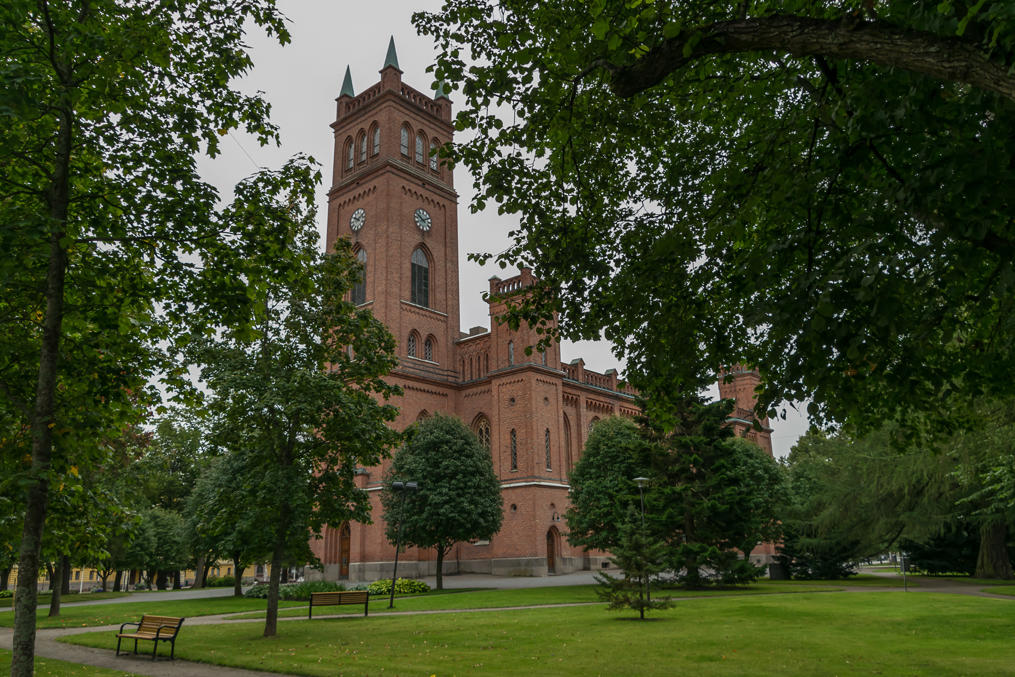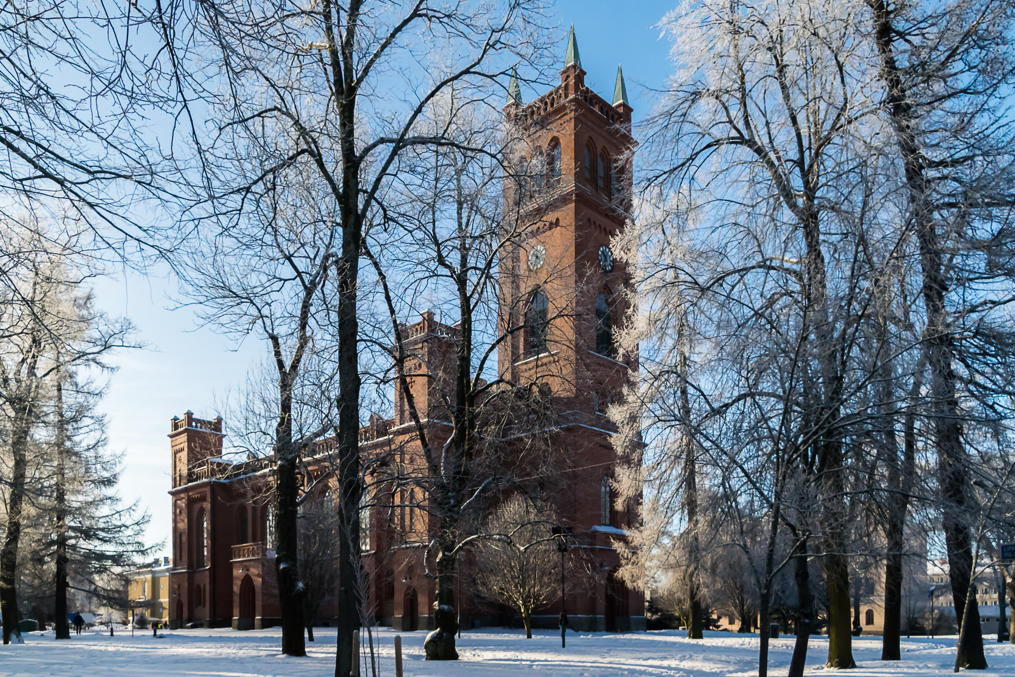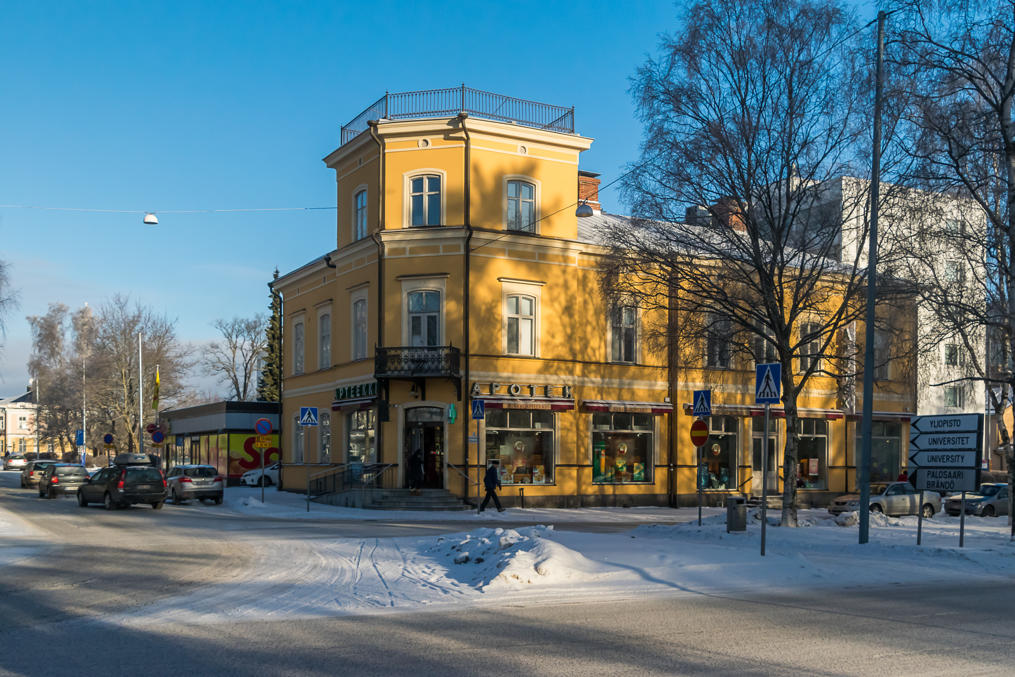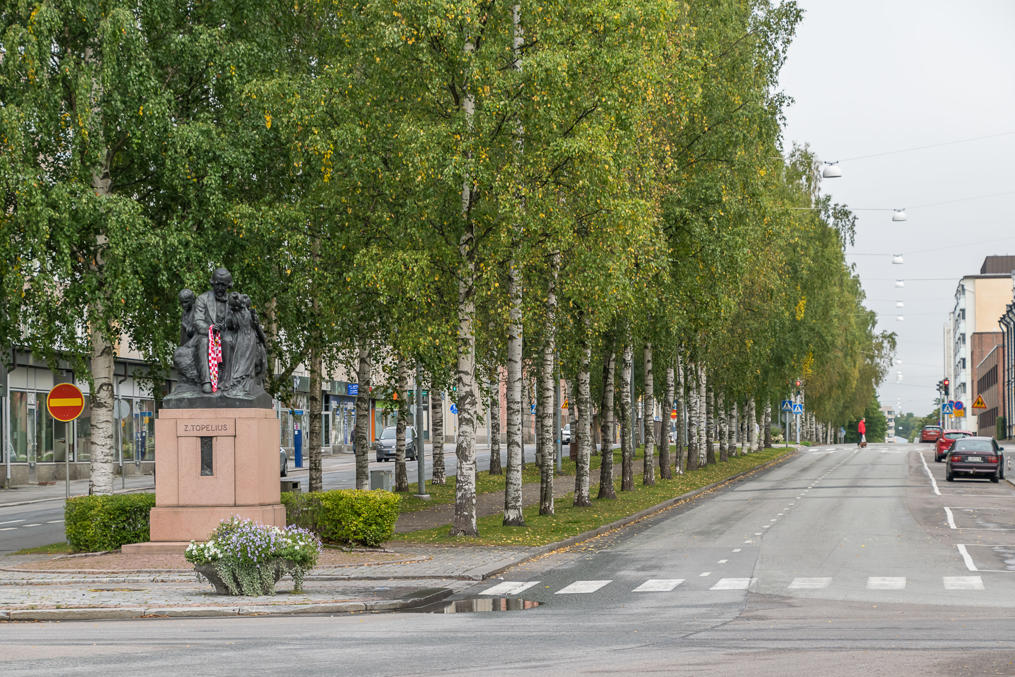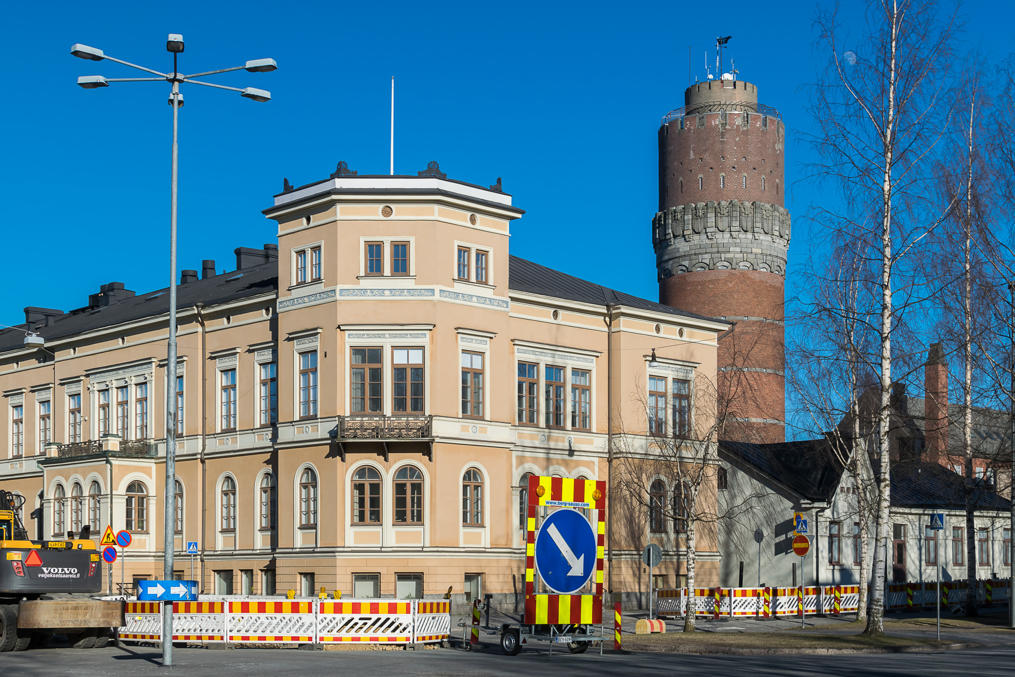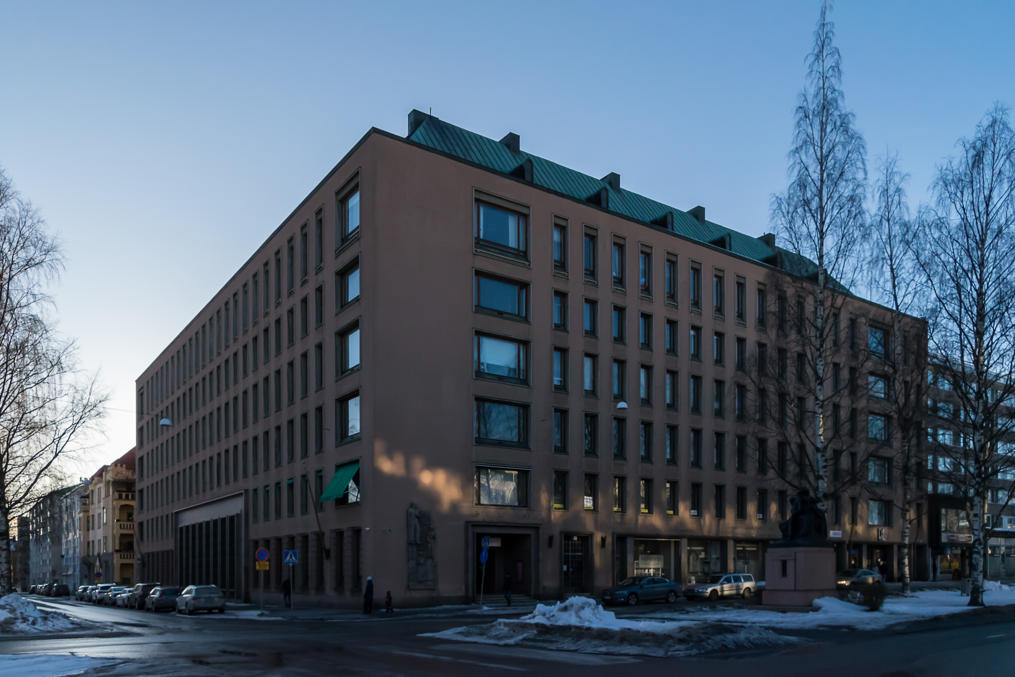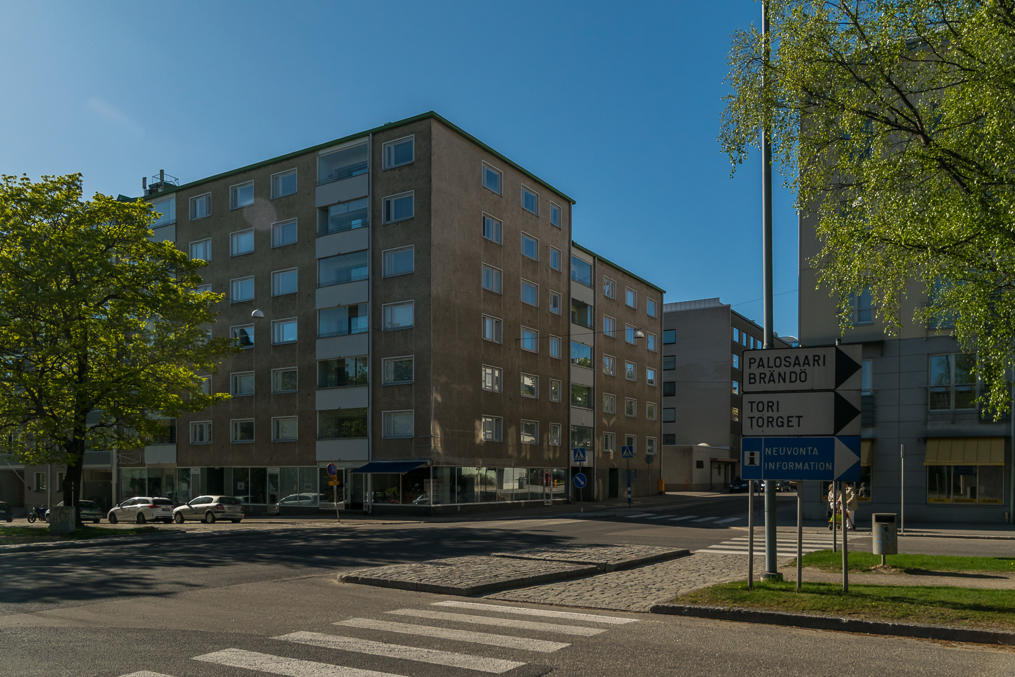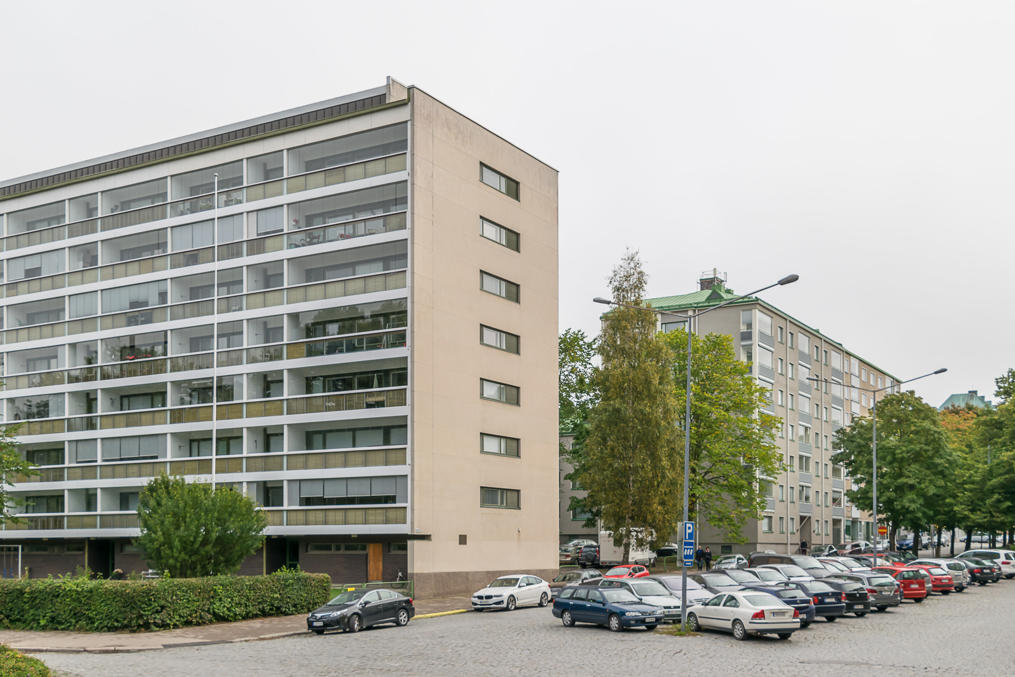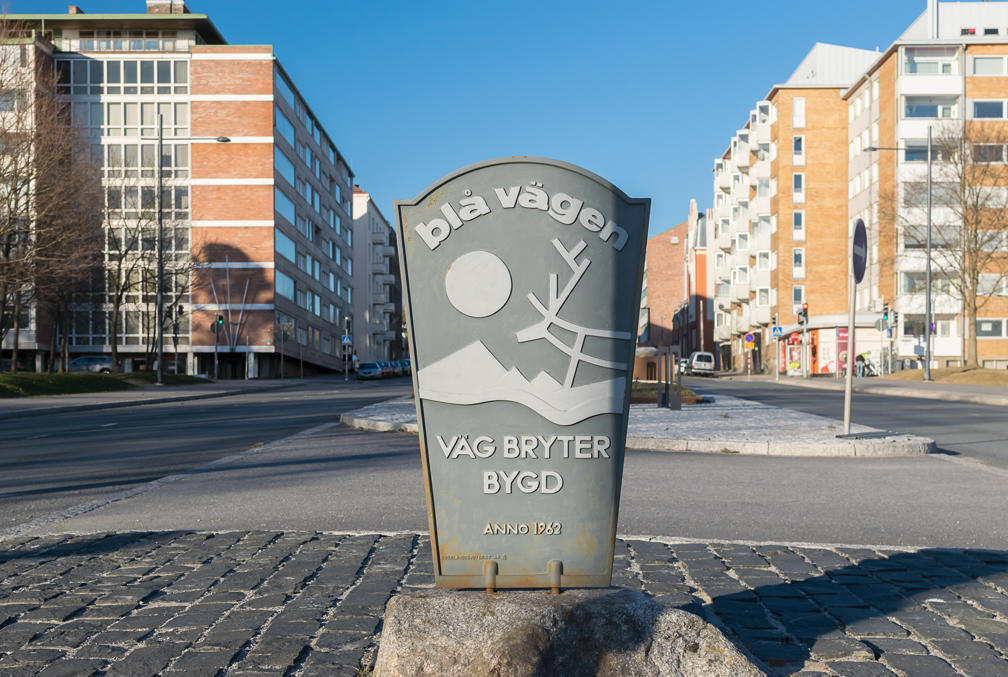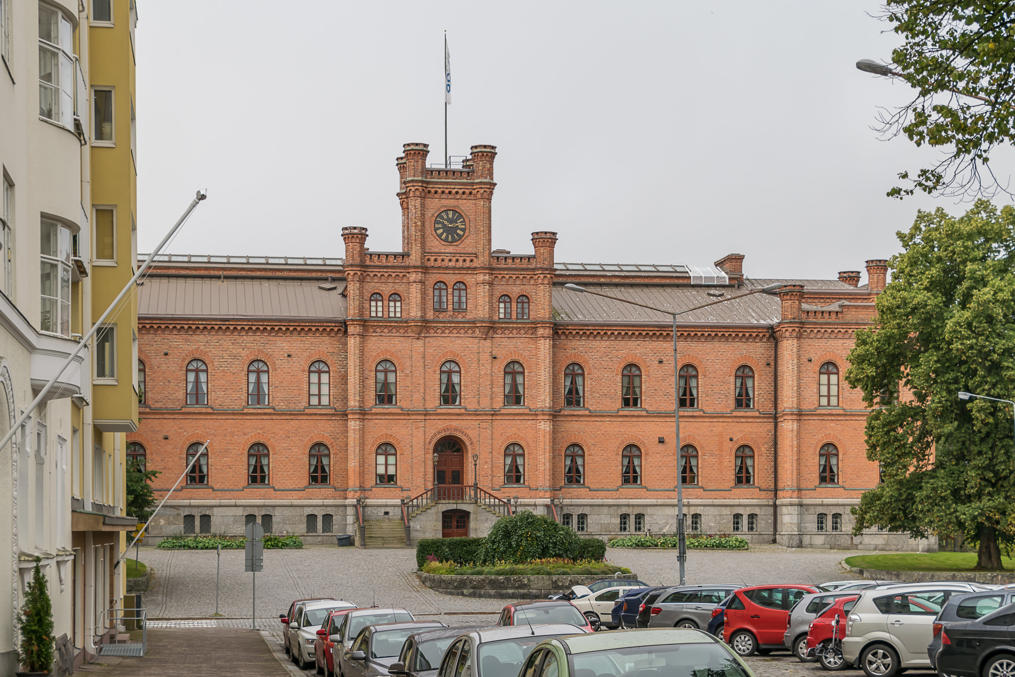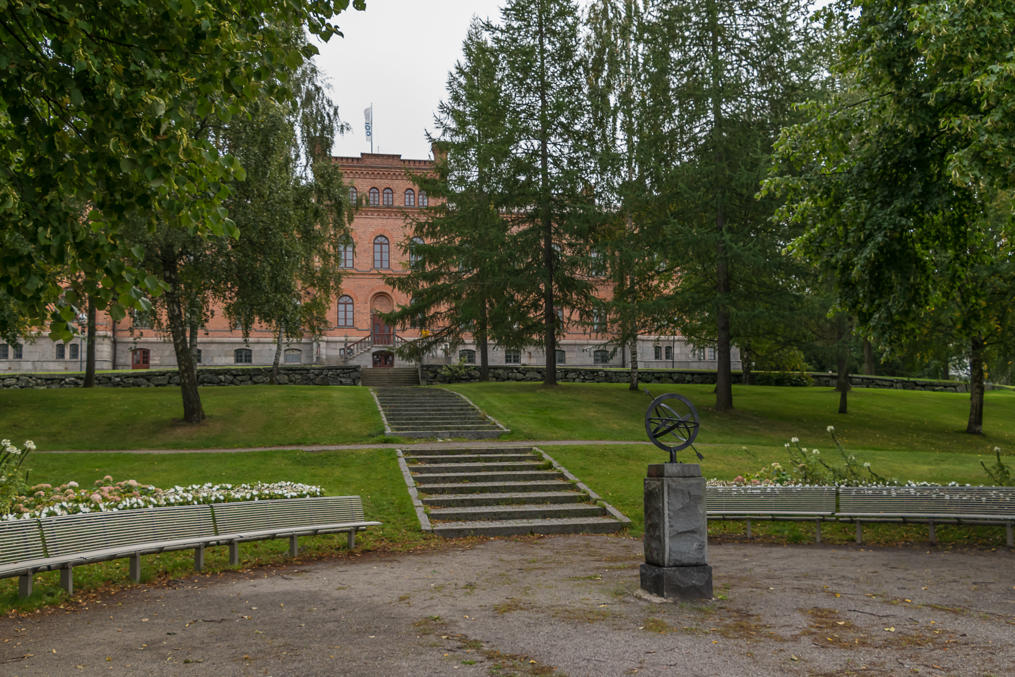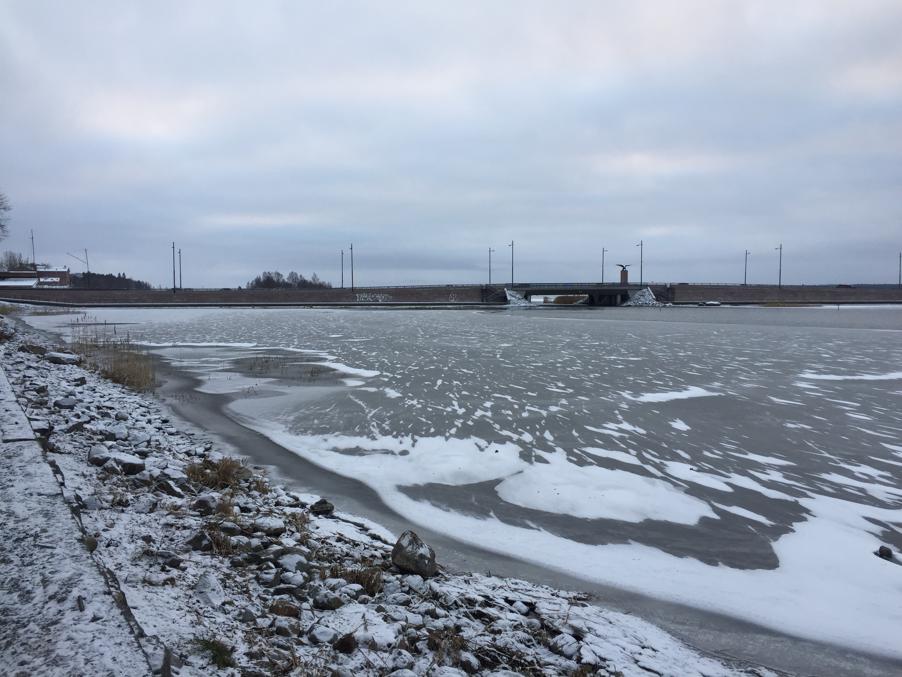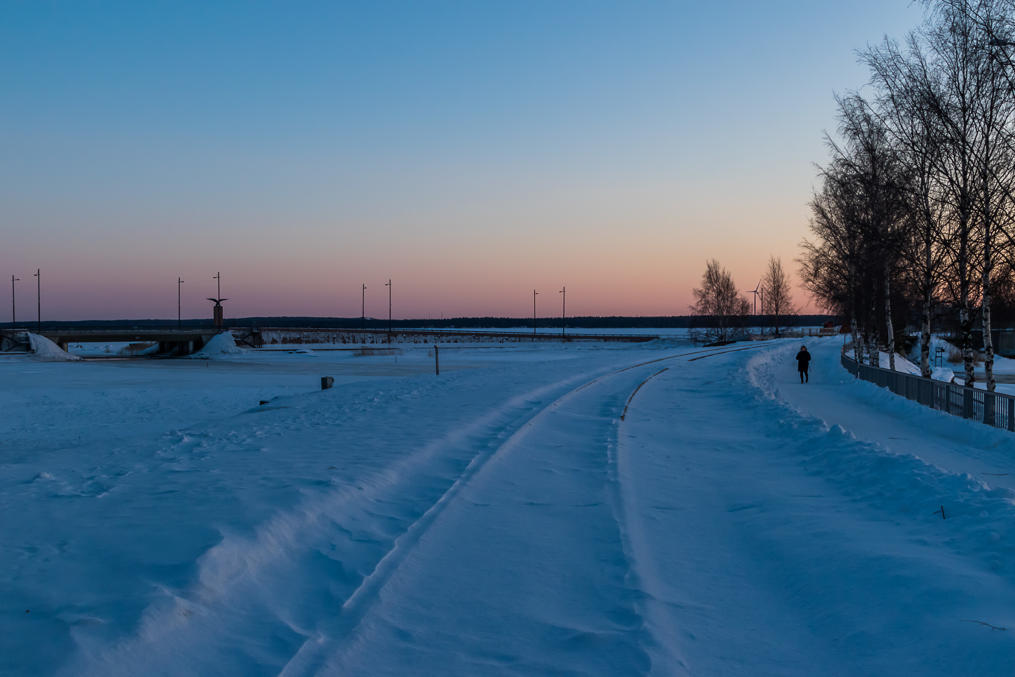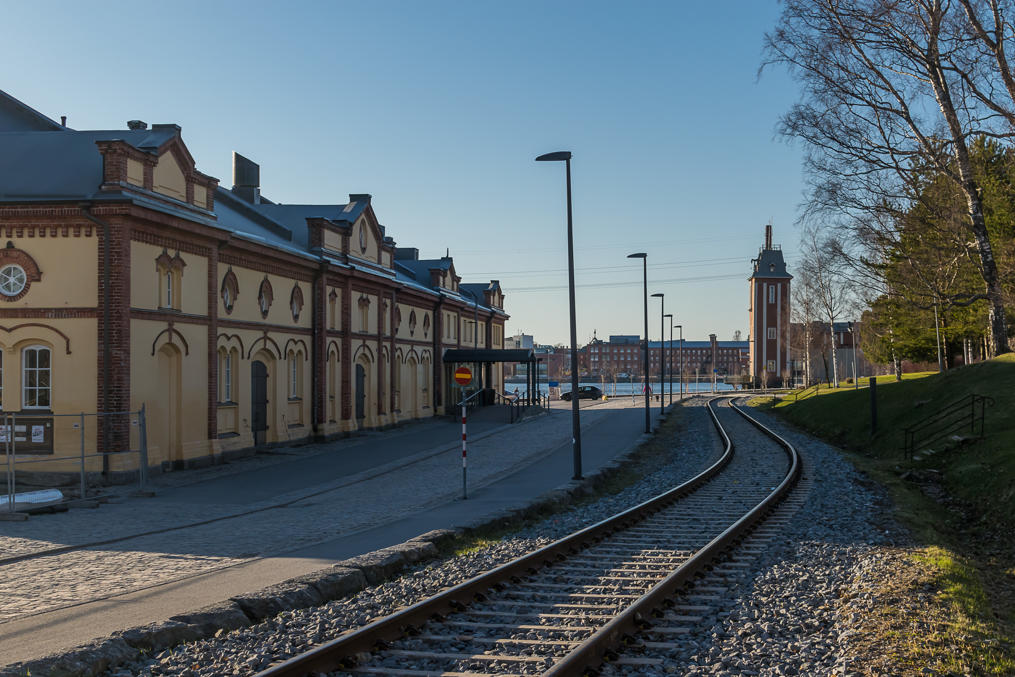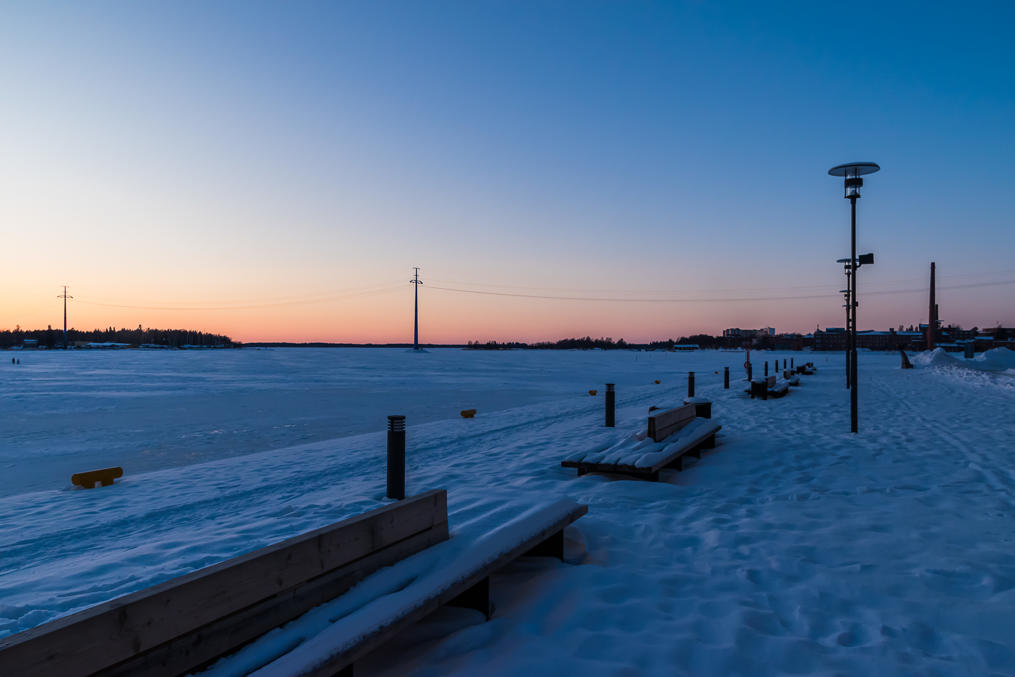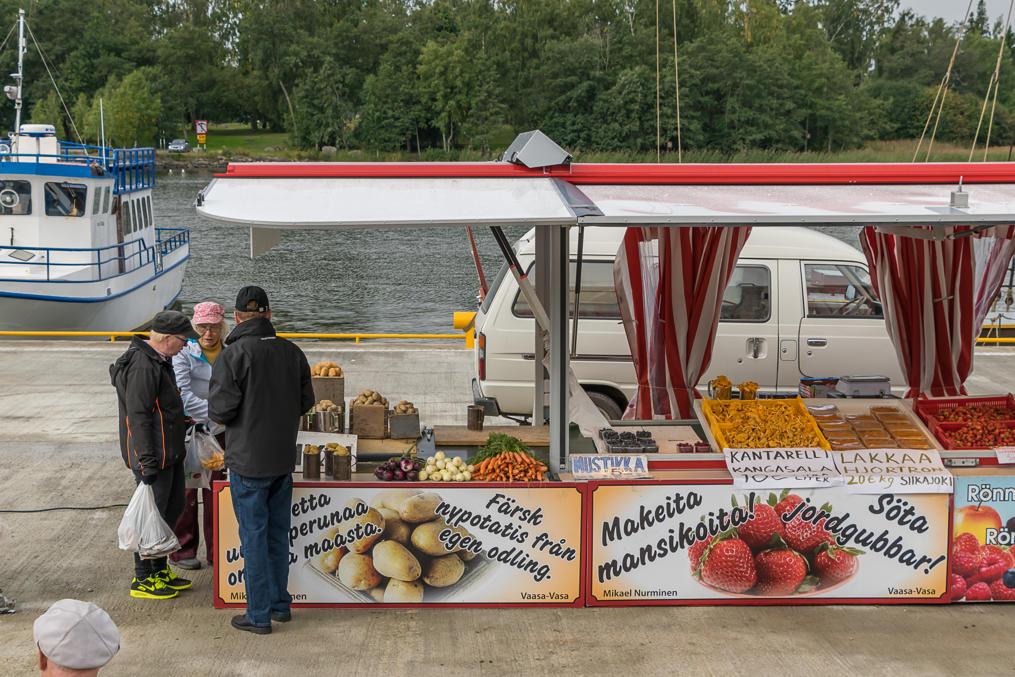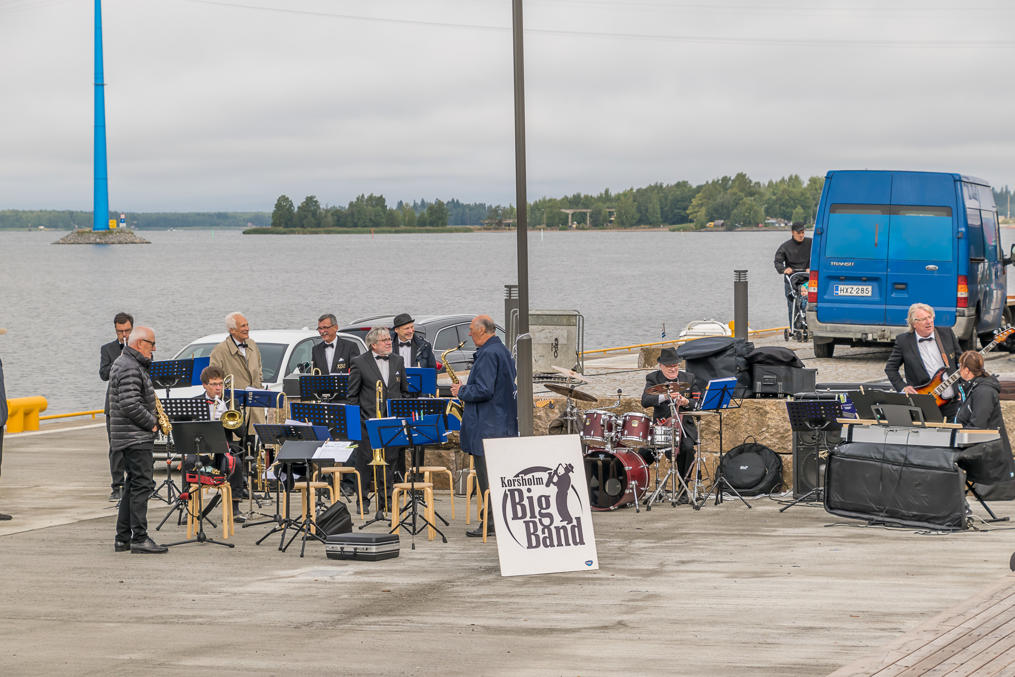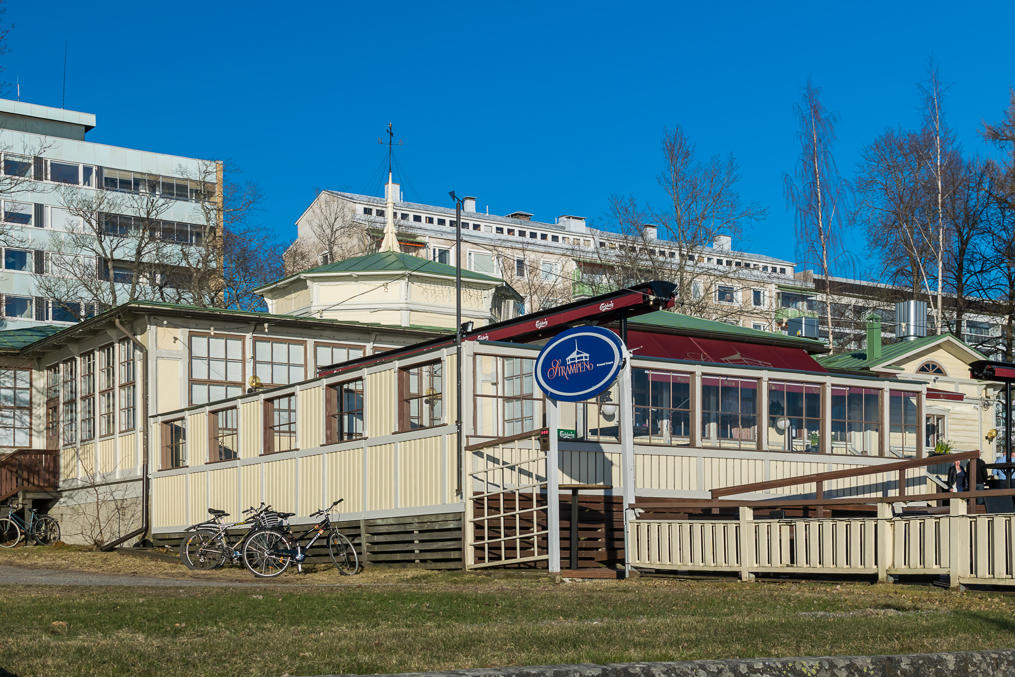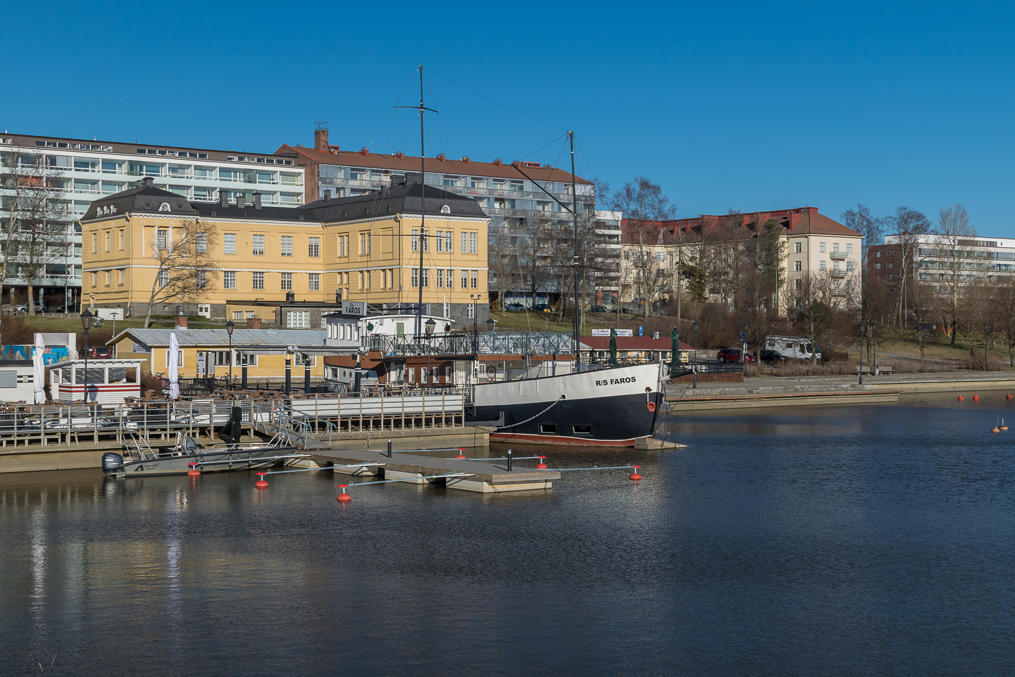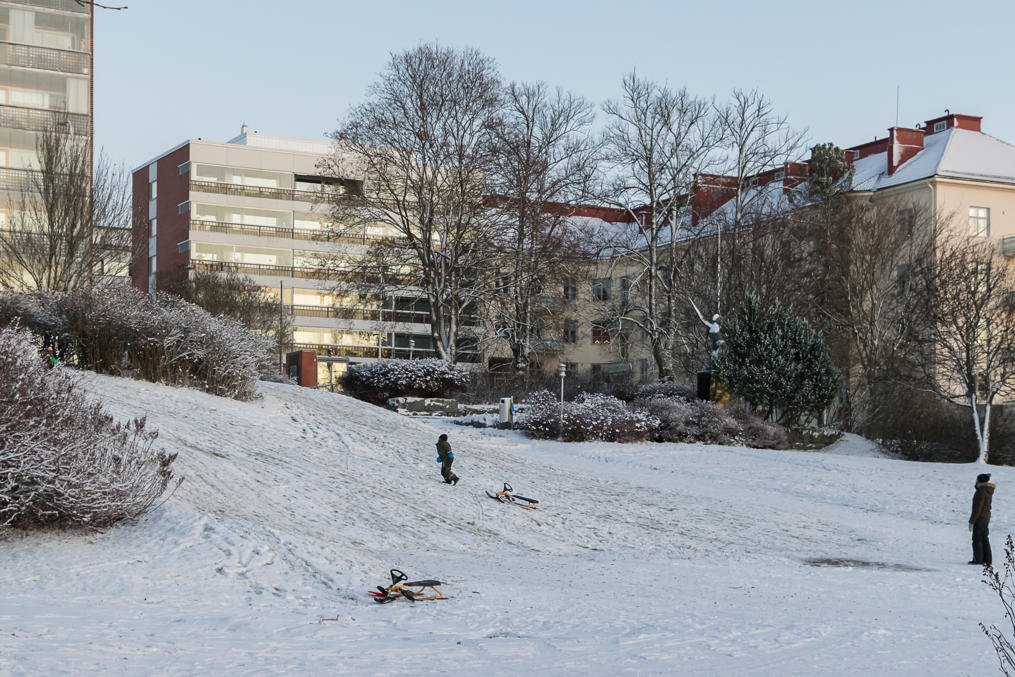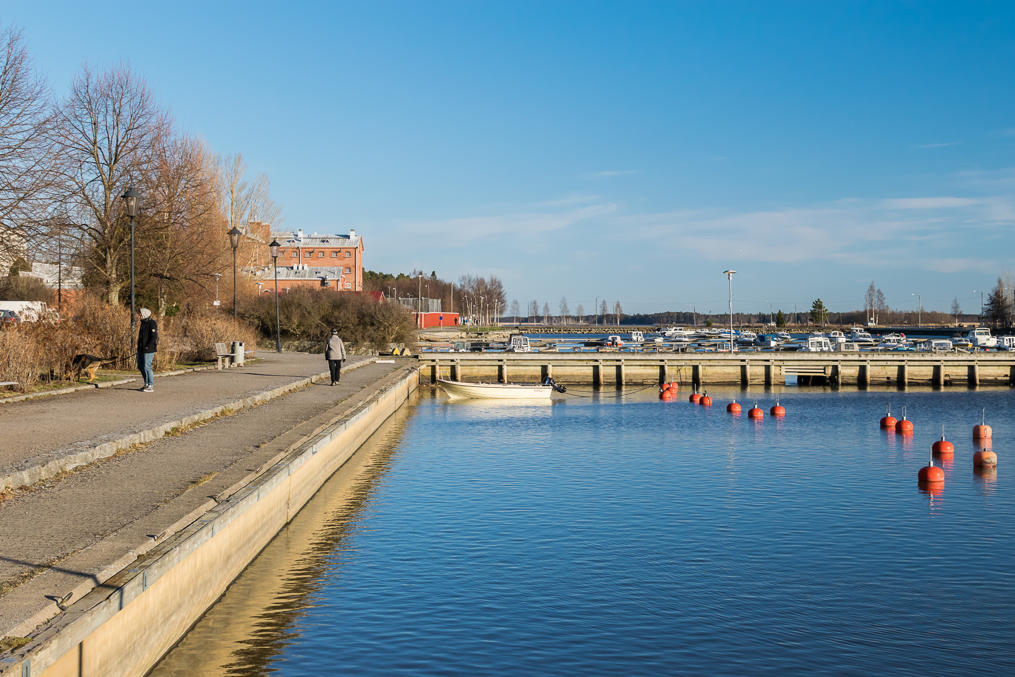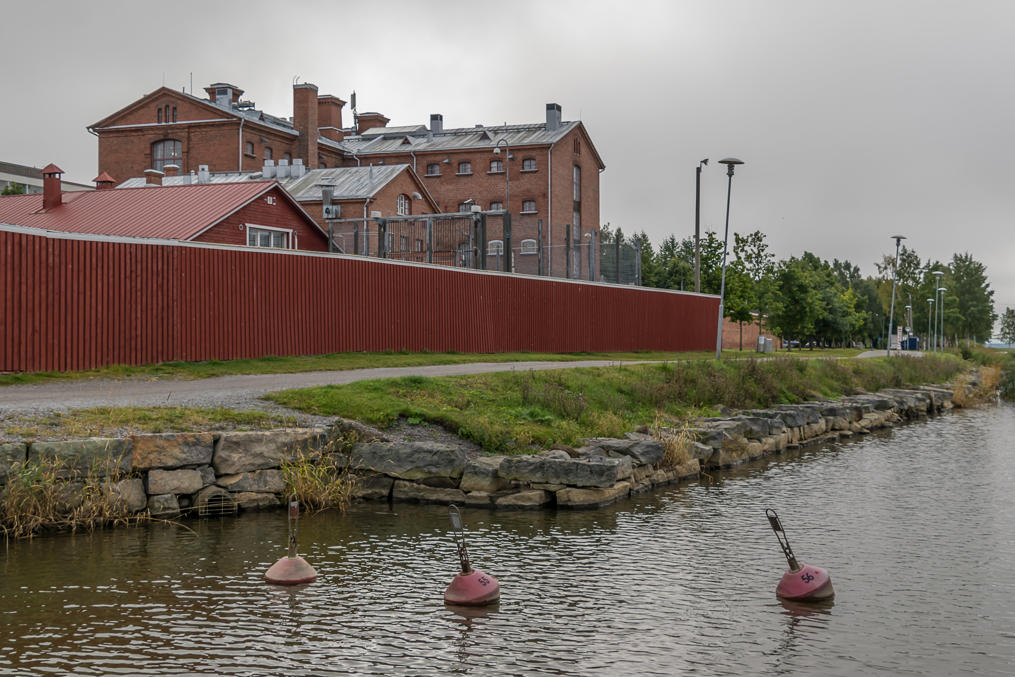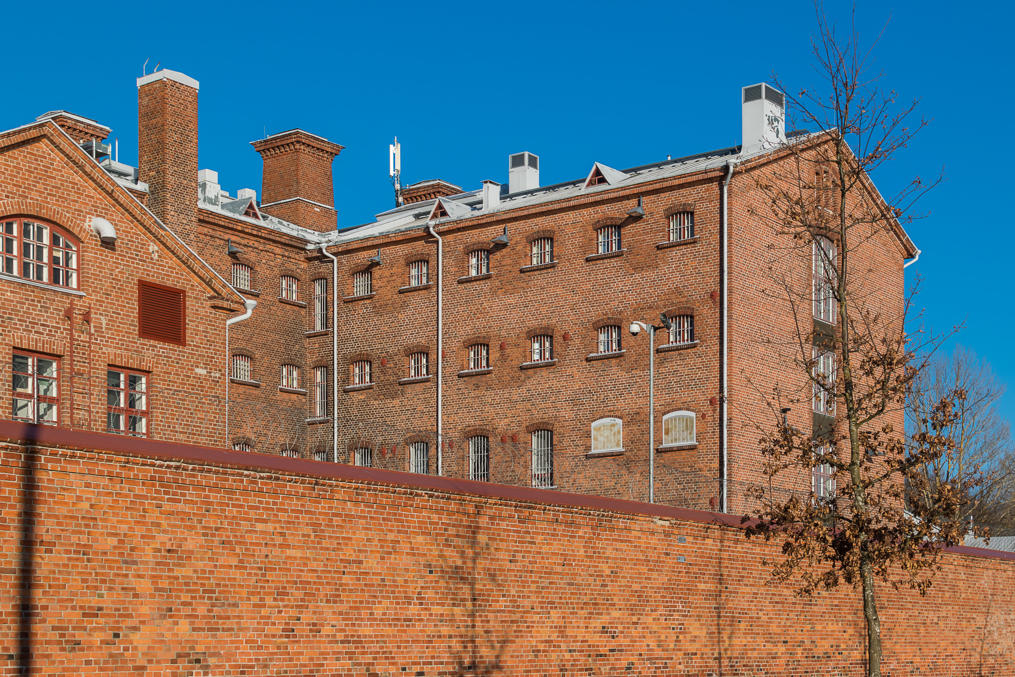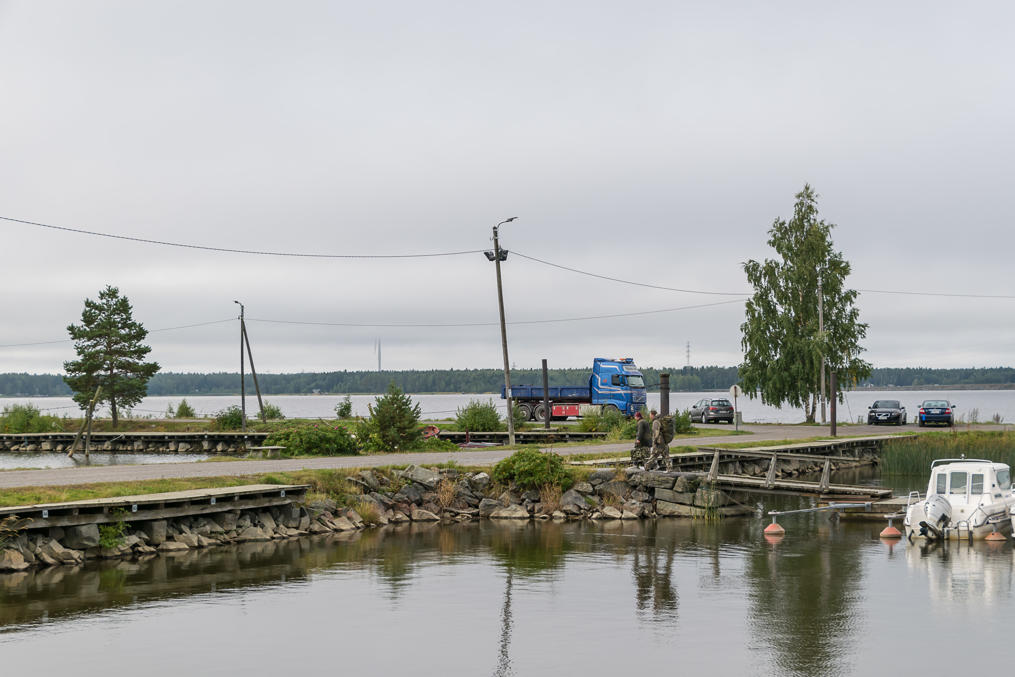And so, without further introduction, let's have a walk around Vaasa.
Area covered in this post:
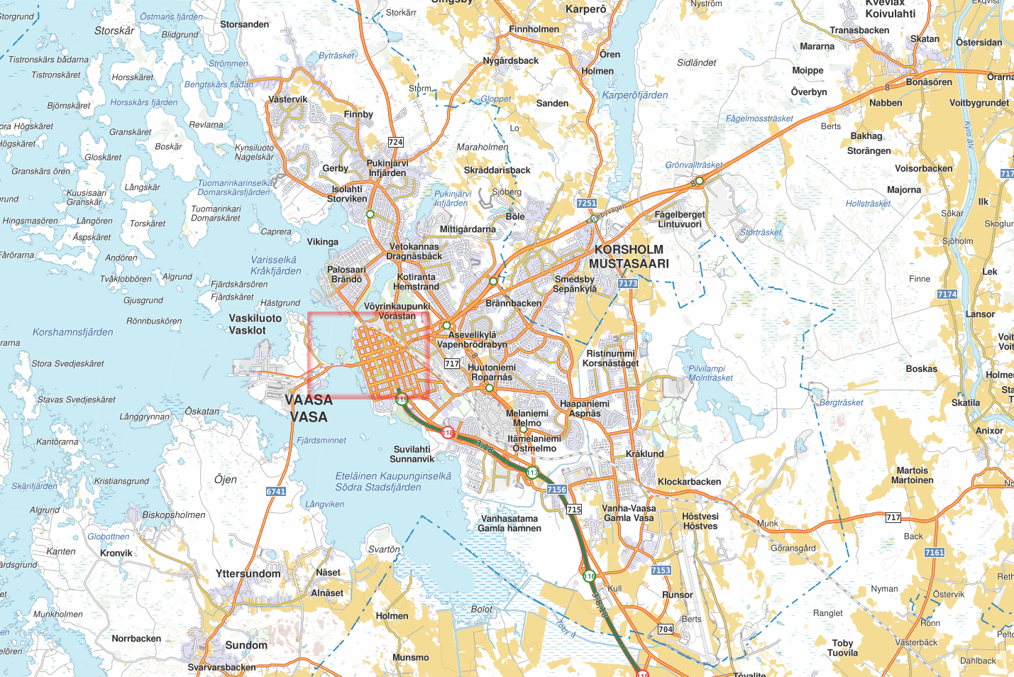
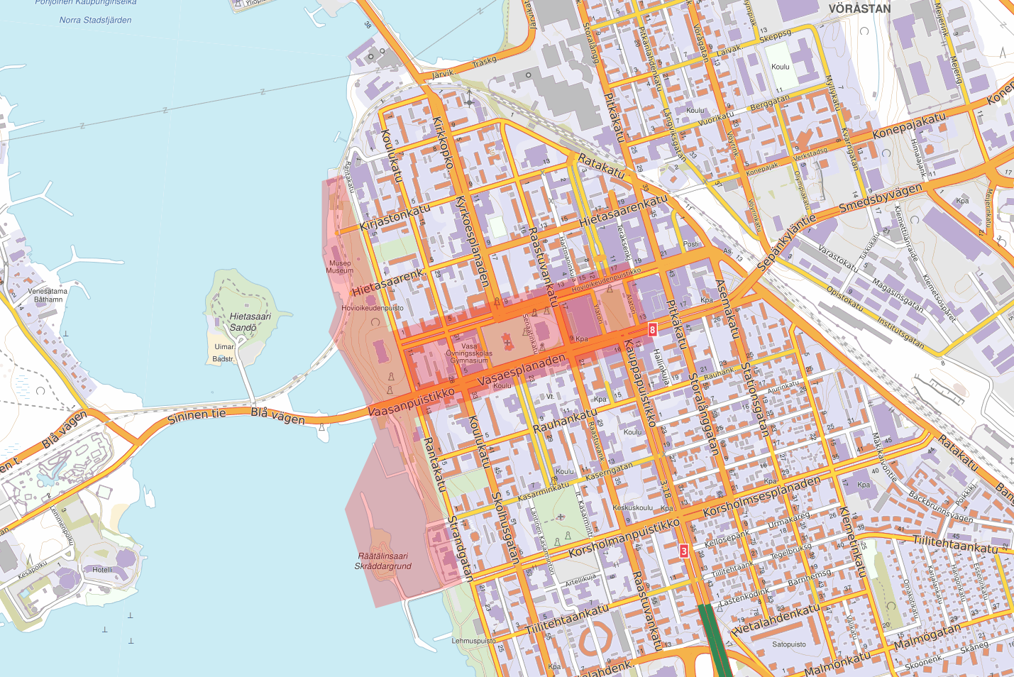
1. And like in every other Finnish city, the heart of Vaasa is its Tori, the central/market square. The one in Vaasa is a mostly empty space, paved with cobblestone, and bordered by the three central streets of Vaasa: Vaasanpuistikko (Vaasa Parkway), Hovioikeudenpustikko (Court of Appeal Parkway) and Kauppapuistikko (Market Parkway).
2. The only structure in the middle of the Tori is the Freedom Statue (Vapaudenpatsas), which was set in 1938 to commemorate the Whites victory in the Finnish Civil War. At the time (and for many decades afterwards too) the view of the Civil War was quite straightforward: the Whites were the guardians of freedom, which protected the newborn Finnish independence, and the Reds were traitors who aimed to rejoin Finland back to Soviet Russia. So the war was called the War of Freedom (Vapaussota), and the monument inscription says: "To the Liberators of the Fatherland". It features two warrior figures on top, the Finnish Lion in the front, Mannerheim carving on the back, and carvings of Work, Future, Law and Religion on the sides. The monument was designed by Yrjö Liipola and Jussi Mäntynen.
A monument to the Reds exists in Vaasa too, but was erected much later and in a much less prominent place, near the Old Graveyard in Vöyrinkaupunki area. We'll get to it eventually.
3. The Tori architectural ensemble works well, but only four buildings there look more or less historical, and none are older than the 1900s. The most prominent one is probably the Hartman House (Hartmanin talo), in the northwest corner of the square. It was built in 1913 by K. S. Kallio, with sculptures by John Munsterhjelm, and is probably one of the finest buildings of all Vaasa. It was renovated recently, in 2017.
The building was built and is still owned by Hartman company (Oy C. J. Hartman Ab), which was founded in 1862 as a hardware store, and still operates as a construction goods sales company in Finland. It is by itself fairly exceptional in Finland that a company has been operating for over 150 years in the same line of business and owned by the same family, and it is even more exceptional that their office is still located in the same building as over 100 years ago. Most of the building admittedly is rented out to other businesses, and I'm a little proud to say I had been actually working in this exact building for 1.5 years, in an office on the fourth floor. It was very nice from the inside too, although the office was fairly small and with an old-fashioned layout (and it was a bit disappointing that the fireplaces in its rooms were no longer in use). Of course the building has been renovated over the years from the inside as well, and it has now for example air conditioning.
4. View from my old Hartman House office windows onto the Tori, at the time of the parade that we'll return to shortly. Two rather similar-looking but differently-colored buildings on the left are the Commerce House and Unitas House, originally both built in 1910s, same as Hartman House. In fact by now all four buildings on that side of the Tori are actually just one building with through corridors, and form Espen (formerly HS Center) shopping center. Somewhat separate from Espen in that super-building remain branches of the two biggest Finnish banks, OP (Osuuspankki, Co-operative Bank) and Nordea.
5. The fourth and the last older building of the Tori is the Market Hall (Kauppahalli). It is in fact the oldest one, with its older part opened in 1902. It is a long low market building with rows of small cute stores. Such markets are fairly common in older Finnish cities. Similar ones for example exist in Oulu, Kuopio, Turku, and Helsinki has three at once.
6. All other buildings of the Tori look fairly boring, some mid-20th century architecture. It was unfortunately a very common tendency in Finnish cities to have splendid old buildings in the center demolished to make way for depressing grey (but more "modern", at the time at least) boxes. Usually it was the fate of smaller wooden buildings, but quite often bigger stone ones suffered as well.
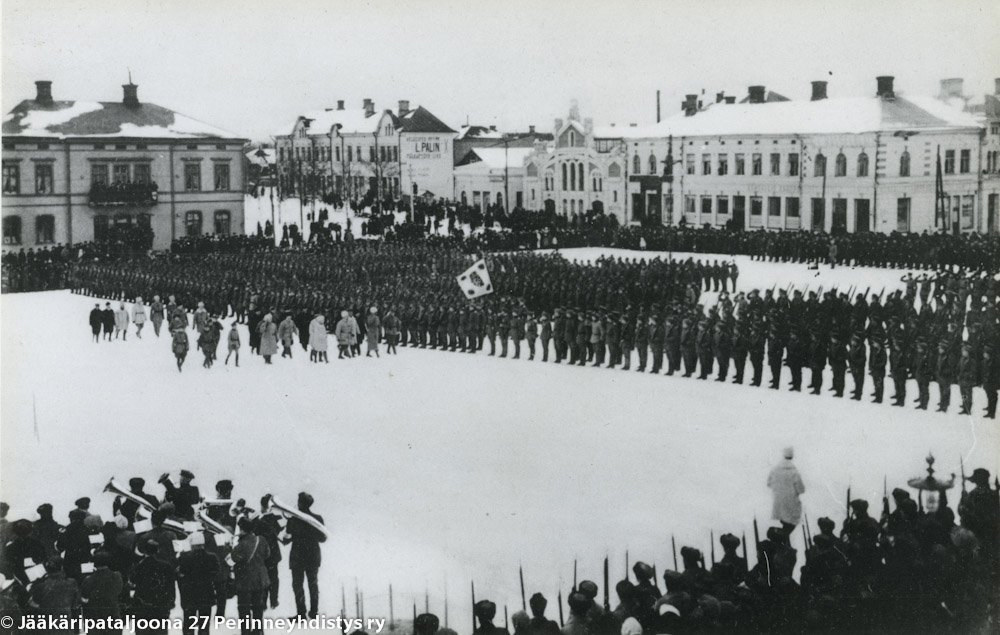
7. For example in a relatively well known picture of jaegers parade on the occasion of their return to Finland in February 1918 the Market Hall (in the middle) is the only building that still exists to this day.
8. The modern building on the west side of the Tori is however also considered mildly notable. It is the Rewell Center, mostly known as the main shopping center of Vaasa. It takes up a whole city block and also houses apartments, offices and a hotel.
The shopping center is named after its designer, Viljo Revell (1910-1964), a prominent Finnish functionalist architect, born in Vaasa. Among his better known works are for example the Lasipalatsi (Glass Palace) and City-Center buildings in Helsinki center. The block at Vaasa Tori was designed by him in 1963. It did not originally include a shopping center; it was added only in 1990, and the Rewell Center (note deliberate "antique" spelling with a w) name appeared only then. Revell himself is buried at Vaasa Old Cemetery.
9. Rewell Center interior. It is not in fact particularly huge.
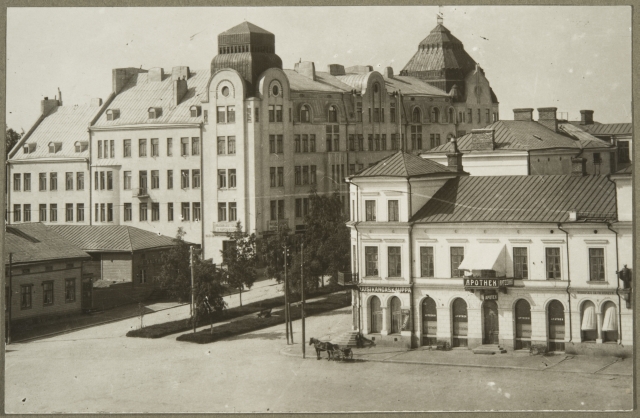
10. Rewell Center's predecessor was the Wolff House (Wolffin talo, in the picture to the right), the office of the biggest shipowner of Vaasa, Carl Gustaf Wolff. It's a bit of a shame that it did not survive. (In the center is the Wasaborg House that did survive, see picture 31 below.)
11. A common renovation for toris in many bigger Finnish cities in latest decades was an underground parking. The Vaasa ToriParkki is in fact one of the older ones, built in 1995. Its entrances are not at the Tori itself but at Kauppapuistikko parkway, a short distance north and south of the Tori.
12. The ToriParkki is a fairly no-nonsense parking, with two floors, simple square layout, and about 840 parking spots (which I've never seen remotely close to being all filled). The prices are, if I remember correctly, 1€/hour, 10€/day, 80€/month. Generally it is more convenient for short-term parking if you have some business in Vaasa center (considering that street parking within a few blocks of the Tori is also tolled and is more expensive than ToriParkki). My coworkers, most of whom actually didn't live in Vaasa proper and were commuting by car, mostly used Teatteriparkki parking house a few blocks away; that one is only 40€/month. Myself I usually took the bus to work, but sometimes just walked and sometimes drove and left the car at a huge free parking lot at the former bus station, just outside city center and in 1 km walk from the Tori.
13. And as for the buses, again, as is customary for Finnish cities of that size, Tori is where nearly all local buses depart from or pass through, so the overall network of about 17 routes is star-shaped.
Buses honestly were the one thing that I didn't really like while living in Vaasa. I had lived in cities orders of magnitude bigger all my life before Vaasa, and using public transport for regular commute (while still having a car for travel or e. g. shopping) was pretty natural for me. In Vaasa I lived in a place away from the center (in 3 km) but with decent bus service (about five bus routes passing by, although they stopped at different stops). However, intervals were inconvenient (20 min on weekdays for the most frequent bus, 30 min for others, on weekends half the buses didn't run at all and others had 1 hour intervals), buses were frequently late (even though in Vaasa there are basically no traffic jams due to its modest size, and anyway I usually came to work and left work fairly late), often didn't show on the online live map, and the screen that showed the next stop didn't work far more often than it did. Buses aren't very convenient for visitors too, with an overinflated cash tariff (3.20€ instead of 1.33€ by bus card; monthly pass is 35€) and no option to pay through an app (and no app at all). As is pretty normal for Finland, buses have decent coverage of the city but suburban buses are virtually non-existent; even bus connection to Smedsby, the Korsholm village immediately adjacent to Vaasa, is quite poor.
But then Vaasa is a city of people who either live close enough to work to walk, or can bike, or drive a car. Driving (and usually parking) there is nice and completely stress-free. Most passengers in buses were school kids or university students, and my coworkers thought I was being a little weird by actually wanting to take a bus. Overall, having visited all major Finnish cities and used buses in a few of them, I can say that local buses get reasonably convenient as everyday mode of transport in cities over about 100,000 population. For example I had decent experience with buses in Kuopio and Jyväskylä. In Vaasa on the other hand it's just some barebones service for people who can't use a car.
That said, overall buses aren't terrible. The bus visible in the picture is one of the new biogas buses bought in 2017. The local recycling plant, Stormossen, produces biogas from biological (=food and sewage) waste, although it's a bit too far from the city, so buses need to drive considerable distance to refuel. Although there are also some older regular buses, which need to replace these biogas ones not uncommonly. Local buses are currently operated by Wasa Citybus company, formed in 1993 as a merger of seven (tiny) local bus companies, the oldest of which dated back to 1928. Their total fleet consists of 25 buses.
14. The Tori on a dark winter evening giving oddly cyberpunk-ish vibe.
15. The Tori of course is a place for celebrations, parades, fairs and other events. One thing you probably shouldn't expect there is a Christmas fair, because this is what it looked it its entirety in winter 2017-2018. I almost never actually saw these little shops open either.
16. In summer the Tori is a place where they sell local fresh produce, berries and mushrooms. This is usually unrelated to any events and a few stands are there every day.
17. This guy selling shoes is there throughout the year though, as I recall. The whole thing is so adorably provincial.
18. Sometimes there are sunday fairs, but don't really expect to find anything exciting there.
19. Lilliputti city tour "train" operates from the Tori in summer, having two different routes. It is quite a decent and reasonably cheap (6€) way to see most of the better-looking parts of the city, so I can recommend that one.
20. Independence Day (itsenäysyyspäivä) celebration on 6.12.2017, the date when Finland actually turned 100. A choir singing. The stage is occasionally used for other concerts too (and more often by teens just hanging around there).
21. In snowy winters there might be enough snow at the Tori for some sledding fun. Pedestrian and mostly-pedestrian streets around the Tori actually have heated sidewalks, and thus are usually snow-free in winter (although in harsh cold, when it's not really slippery anyway, those are turned off). The bulk of the Tori area is of course not heated.
22. Politicians meet with their voters during their election campaings at the Tori or nearby. At the time of the President elections of 2018 I was lucky enough to see the President of the Republic Sauli Niinistö running for the reelection. He was meeting with voters in the Rewell Center. (He won a landslide victory, as he's extremely popular in the country.)
23. You can see the severe-looking guard in front, but overall Mr. President and his spouse were really close to ordinary people, in fact I could have shaked hands with him, but he was doing that only for a few minutes and in the end I wasn't decisive enough. There weren't any other visible security measures, no security screening at the entrance or something, and just a few police cars outside. Everyone could have walked in freely.
I really rather like this tradition of openness, which of course is not unique to Finland, but still quite unlike my native Russia. Of course the common counterargument is "the president here doesn't decide anything, who cares if he's assassinated or something". Which is largely true, but still 1) it definitely would matter very much in Finland and would be a pretty big shock for the country; 2) he does decide some things, some of them explicitly but also he is just a very influential person in general and has a great amount of soft power, and unlike most current European monarchs he can and does use that on the occasion; 3) the people who do have power (the prime minister and the leaders of the coalition government) have in practice even a more low-profile life and even fewer guards etc.
24. More political life in Vaasa, an election poster of the Finnish Communist Party (to the left), with actually rather cool design. "From the rule of money, to the rule of the people!" The Finnish Communist Party (SKP, Suomen Kommunistinen Puolue) has been extremely marginal in Finland. Its modern incarnation has been re-established in 1996 (the previous one having disappeared with the fall of the Soviet Union which had been supporting it), but has never managed to elect anyone to the parliament. Virtually no one in Finland has ever wanted to go full communism, but less radical leftist parties are moderately popular (Left Alliance, Vasemmistoliitto, is a part of the current government). Of course the Tori is not the only place with election posters; in months preceding the parliament elections of 2019 those were everywhere.
25. Parades are not a very common occasion at the Tori or in Vaasa in general, but I got to see one on 24.2.2018, at the 100-year anniversary of jaegers returning to Finland to fight for the Whites in the Civil War. Jaegers (jääkärit) were young Finnish men recruited and trained by Germany in the 1910s to fight in the World War I, who then (with Germany's consent) provided crucial help for White Guards. Lt. Gen. Petri Hulkko, the land forces commander of the Finnish Defense Forces, inspects the parade. You can see the parade also on the picture 4 above.
26. From the Tori, the parade marched down the Vaasanpuistikko to Vaskiluoto Island.
27. A unit wearing war-time Finnish uniforms.
28. Vaasans looking at the parade.
29. The Tori is only about 700 m, or 4-5 blocks away from the sea waterfront at Hoviska (Court of Appeal Park) and Inner Harbor. Both streets leading there from the Tori, Vaasanpuistikko and Hovioikeudenpuistikko, are quite nice walks. This is Vaasanpuistikko (Vaasa Parkway), which in some way may be considered the main street of the city; it is a direct continuation of the Kokkola Road leading to the city from the northeast, and passing from the center it continues on to Vaskiluoto Island and its harbor. Parkways of Vaasa center and their continuations are the only four-lane streets in the entire city; all other streets have only two lanes (although usually lanes are wide enough to accomodate street parking without much difficulty).
30. Hovioikeudenpustikko (Court of Appeal Parkway) on the other hand is split in two by a pedestrian-only section at Tori, so it does not get that much car traffic. At both Vaasanpustikko and Hovioikeudenpustikko there are a few well-preserved older stone buildings. In Helsinki center they wouldn't have stood out much, but here in Vaasa there are few enough of them that each one is really unique and drawing attention.
This building of the corner of Hovioikeudenpuistikko and Raastuvankatu (City Hall Street) is Kurtenia House (Kurtenia-talo), or the former Vaasan Co-Operative Bank (Vaasan Osake-Pankki). The jugend-style building is named after Anders Joachim Kurtén (1836-1899), one of the most important people in Vaasa history in the second half of the 19th century. Kurtén, son of a sea captain, participated in or established some key local enterprises of the era, including the Vaasan Co-Operative Bank, Vaasan Steam Mill (Vaasan Höyrymylly), and Vaasan Cotton Industry factory (Vaasan Puuvillateollisuus). He was also a politician both in the city council and in the Diet of Finland, the latter at the time being a body with representatives of four estates; Kurtén of course belonged to the burgher estate. The Kurtenia House, built in 1905 already after Kurtén's death, was named in his honor (and a monument to him is just across the road near the City Hall). The house still holds a bank office with authentic interiors, only it's now Ålandsbanken (Bank of Åland Islands) there, a relatively exotic bank chain for mainland Finland. Vaasan Co-Operative Bank, not to be confused with modern Vaasa branch of the OP (Osuuspankki), operated in 1879-1920, after which it merged with two others. After four more mergers and buyouts over the last century, it is now theoretically a part of Nordea, although in practice there probably aren't any surviving traces of Vaasan Co-Operative Bank within Nordea.
31. Vaasanpuistikko has another prominent jugend-style building, Wasaborg House (Wasaborgin talo). The spendid building was built in 1912 by Hugo Sjöblom, a local businessman who got rich in trade in "colonial goods", but suddenly died shortly after the building had been finished. His widow sold it to the Wasaborg real estate company. In 1920-1970s Kahvi-Komppania shop, selling, again, "colonial goods" (such as coffee) operated there, and the building was known as Kahvi-Komppania House even afterwards. By now it is known again simply as Wasaborg House, and houses some relatively minor businesses only.
32. View down the Raastuvankatu to the south by the Wasaborg House.
33. Between the Vaasanpuistikko and Hovioikeudenpustikko is the City Hall, built in 1883 by Magnus Isaeus. The building has been housing various city offices since the beginning and is still used for the original purpose, but also there is for example a concert hall on the third floor.
34. City Hall in summer.
35. City Hall staircase. Apart from the splendid interiors it also has some works of art.
36. In the small park near the City Hall and the church there are a few monuments. This one is for marine pilots.
37. The small street where the City Hall is located is called Senaatinkatu, Senate Street, after the Finnish Senate's temporary relocation to Vaasa during the Civil War of 1918 (mentioned in the previous part). The Senate operated in the City Hall, and the White headquarters was in the Governor's House (Maaherrantalo) a bit away from the center. Vaasa generally has this rather nice feature where many street signs actually briefly explain the meaning of the name; this is something unique for Vaasa and not seen in other Finnish cities.
38. The next building to the west is the main church of the city. As is usual in Finland, the church is generally known just by its location, as Vaasa Church (Vaasan kirkko), but it also has another name, St. Trinity Church (Pyhän Kolminaisuuden kirkko). Built in 1869 in English gothic style, it belongs to a group of the oldest buildings of modern Vaasa, designed by the same architect who laid out post-fire new Vaasa plan, Carl Axel Setterberg. It is not especially fancy looking as far as Finnish churches go, but I like the four spires on top of the square belltower, which for some reason gives me an impression of Sauron's Barad-dûr tower from the Lord of the Rings movies, especially so because it is one of the highest buildings of the city and is quite prominent when looking onto the city from the sea direction. I have never been inside though; never had any real reason to, and I feel very awkward in churches. This is not the only church in the city, there are several smaller ones in other areas than the center.
39. Vaasa Church in winter.
40. Across the church is the Vaasan Church Pharmacy (Vaasan Kirkkoapteekki) in a cute small building. The pharmacy dates from 1903, but originally operated in Palosaari; the modern location (and name) were chosen in 1940. This is one of the three pharmacies in Vaasa center, and they alternate longer shifts (until 22:00 daily, including Saturday and Sunday) between each other every week.
41. From the church, Kirkkopuistikko (Church Parkway) goes to the north towards Palosaari, another one of Vaasa parkways. It begins with a statue of Zachris Topelius (1818-1898), the best known Finnish fairytale writer. His fairytales are generally extremely moralizing and religious, and are not very fun to read these days, unless your idea of fun reading is something like "little Rafael died and never saw his last spring, and his parents and siblings were very sad but then realized he's now in heaven with other little angels and there's always spring there, and so they stopped being sad". Topelius, like other early Finnish writers, actually wrote in Swedish (and was a Finnish Swede). He was born in the town of Nykarleby, 75 km north of Vaasa, and had no major connections to Vaasa itself; nonetheless this is where his first monument anywhere was opened in 1915.
Topelius monument is the one monument in Vaasa that occasionally gets decorated; it gets a (huge) graduation cap for student celebrations on Vappu eve (30.4-1.5), and in the picture Topelius is wearing the scarf of Vaasan Sport, the very unimaginatively named local ice hockey team. Vaasan Sport has had generally mediocre success but in the 2010s managed to return to Liiga, the Finnish top ice hockey division.
42. Kirkkopustikko continues on to the south from the church as well. On the corner of Vaasanpuistikko is the Administration House (Hallintotalo). It is another of Setterberg's buildings, built in 1862 for some Herman Lindebäck, a pharmacist. The building has been owned by the city since 1911, and it is this building, not the City Hall, that currently has the mayor's office and hosts city council meetings.
The more prominent landmark can be seen in the background; it is the Water Tower from 1915, 49 m high and holding 525 m3 of water. Water towers are generally prominent in Finnish cities, but usually those are characteristic newer concrete designs, looking a bit like UFOs. In Vaasa however not only the old water tower is preserved, but it is also still used for its original purpose, making it the oldest operational water tower in the country. Although water supply network has changed a lot since the tower was built, and there are now much larger water storage tanks and pumps at the modern water treatment plant, the tower still balances the pressure in the water network. Unfortunately its observation platform was closed in 2009 for some safety reasons. The inside of the tower (the part that is not occupied by the water tank, of course) is still used for climbers practice.
43. The building across the Church Pharmacy is already much newer, the Bank of Finland House (Suomen Pankin talo) of 1952 by J. S. Sirén, same architect who built the Parliament building in Helsinki. The building is better known not for the Bank of Finland but for Ritz cinema that has been operating in it ever since the house was built. Current Ritz is more of an arthouse place though; the one and only "ordinary" modern cinema in the city is BioRex Vaasa. There is also a small but fairly interesting Veterans Museum (Veteraanimuseo).
44. The Bank of Finland House includes a pair of rock carvings with appropriately severe-looking Finns pictured.
45. The remaining two blocks until the waterfront have few prominent buildings, mostly rather generic older apartment blocks.
46. Up until the Rantakatu (Coast Street). The building on the left is already facing the sea (although you have to live on the higher floors to actually see it from behind the trees of the Hoviska park).
47. Vaasanpuistikko ends with the sign of the Blue Road (Sininen tie, Blå vägen in Swedish). It is the oldest official tourist route of the Nordic countries, and to my knowledge still one of only two international ones; it goes from Mo-i-Rana in Norway across the mountains to Umeå in Sweden, then across the Kvarken to Vaasa, across Finland via Kuopio and Joensuu, and then even to Russian Karelia, to Sortavala, Petrozavodsk and Pudozh. Like all such routes though it's not really that special; there are some sights along it but there are some sights everywhere, and the road itself mostly isn't unusually scenic. Nonetheless the route exists and is signposted in Finland. The sign in Vaasa is at the western end of its Finnish section, although it's pretty funny that it is showing a reindeer and mountains, things that most definitely cannot be found along its route in Finland. Although it can serve as a reminder that if you're going the opposite direction, that is, boarding a ferry in Vaasa and continue driving straight on from Umeå, eventually you will encounter reindeers and then mountains.
48. Indeed, Vaasanpustikko continues as a road on a causeway across a sea strait to Vaskiluoto Island and the seaport, and the street name of this road is also Sininen tie. The landmass on the horizon is Vaskiluoto and chimneys belong to the Vaskiluoto power plant. We will have a post about Vaskiluoto later.
49. And Hovioikeudenpuistikko ends at the Vaasan Hovioikeus, the Vaasa Court of Appeal (literally Court of Royal Court). Regular courts in Finland have three levels: 20 district courts (käräjäoikeus, literally Folksmoot Court), 5 courts of appeal, and the Supreme Court (Korkein oikeus). Vaasa Court of Appeal was the second one established in Finland, in 1776 by the orger of King Gustav III (the first was the Turku one in 1623, and the next was the Vyborg one in 1839). The court has long been a major institution of Vaasa, predating also the fire of 1852; although its building in Old Vaasa was spared by the fire, it nonetheless was moved to this location, to the Setterberg-designed red brick building on the waterfront, in 1862. It has jurisdiction over Coastal, South and Central Ostrobothnias, and also Satakunta and Central Finland regions.
50. The park strip between the court and the waterfront is known as Hoviska after hovioikeus.
51. The water area in front of Hoviska is a calm triangular bay, bounded by Vaskiluoto car and railroad causeways. Hoviska and its waterfront is the traditional place of student drinking on Vappu eve.
52. Another thing they do on Vappu eve is put a student cap on Topelius statue, as I mentioned before. Colored overalls pants with various patches is the traditional festive garb for Finnish students.
53. Hoviska waterfront in less nice weather.
54. Railroad causeway in winter. Vaasa-Vaskiluoto railroad stretch, just a few kilometers long, curves around the city center from the north, along the waterfront, and then crosses to Vaskiluoto via causeway. Originally it was of course built for the harbor, but the cargo harbor or other Vaskiluoto industry do not really use it anymore, except random very rare deliveries. It is more common to see trains loaded with timber going from Vaskiluoto, which of course looks a bit odd; but Vaskiluoto station has a timber loading area, and thus is simply used to load timber from local Ostrobothnian woods on trains to ship it to somewhere else in Finland. Even so timber trains are fairly rare too; I've seen them only twice in my 1.5 years in Vaasa (when I worked in the center and crossed the railroad daily), and in winter it is common to see rails covered with snow for a week or more. Oddly enough the railroad stretch nonetheless had a major renovation as recently as 2016.
55. Jaeger monument at Hoviska. As mentioned before, Vaasa was the city jaegers arrived to in 1918, hence the monument.
56. Near the Hoviska is the Inner Harbor (Sisäsatama), usable by smaller ships (fairway 3.8 m deep). Old customs warehouse building in the Inner Harbor from 1879 has been used for the Kuntsi Modern Art Museum (Kuntsin modernin taiteen museo) since 2007. The museum is named for the art collector whose collection became the foundation of the exhibition, Simo Kuntsi (1913-1984). Having rather limited interest in art, especially modern one, I never visited it myself.
The railroad in the picture is of course the same Vaskiluoto line. The line had passenger service many decades ago, and one of its stops was here at the Inner Harbor. There have been some very tentative plans to launch an urban passenger train line (existing railroad layout is relatively favorable for that), but no earlier than 2030s in any case. Currently Vaasa, like most places in Finland, has only long-distance service.
57. Inner Harbor quay, recently renovated.
58. Same quay in winter. Power line across the sea strait from the Vaskiluoto power plant is a characteristic feature of the landscape here, and its pylons are built a little fancier than normal and painted blue to make them less ugly.
59. Older/inner harbors are traditionally home to tour boats offering short cruises around the local lake or sea area. In Vaasa there is only one such boat, the Tiira (Finn. tern, in the picture to the right), from Midsummer to mid-August offering trips through Vaasa Archipelago to the island of Kuusisaari (Granskär), where the Jannen Saluuna restaurant is.
60. Fish fair in the Inner Harbor, although to be honest it was more of a small generic fair; there was not all that much fish. The most commercially important Bothnian fish by far is just ordinary herring. Yearly commercial fishing quotas are however now decided by the EU, and are tight enough in practice that they get used up by early summer or so. Finnish herring quota for all areas of the Gulf of Bothnia for 2019 was 72,724 tons.
61. Sea buckthorn jams, however, are absolutely obligatory — sea buckthorn being the traditional Bothnian berry.
62. There must be an orchestra too of course!
63. Strampen, one of the best known restaurants of Vaasa. I even was there once! At a work party but still.
64. Farther on to the north is the former steam mill. Vaasan Steam Mill Company (Vaasan Höyrymylly Oy) was one of the most important enterprises of the 19th century Vaasa. It was founded by August Alexander Levón, a man from a farmer family, who studied to be a pharmacist, but his application to open a new pharmacy in Vaasa was rejected. So he decided to do something completely different, bought a plot of land near the Old Vaasa, named it Alkula, and established there in 1849 the first ever flour steam mill in Finland! It was not a huge one, but it allowed Levón to get rich, and he founded and participated in some other industries in Vaasa, along with Kurtén mentioned above. He died in 1875, and in 1876 the mill was moved to the outskirts of the post-fire Vaasa, where it got its own harbor and eventually the entire prominent group of industrial buildings. The mill operated in Vaasa until 1992; although Vaasan is still an existing and very well known brand of Finnish bread and bakery products, it actually no longer has any production in Vaasa. Mill buildings are now used by the Vaasa department of Åbo Akademi, the only full-fledged Swedish-language university in Finland, based in Turku. Grain elevator building from 1950s was planned for rebuilding into student housing, but turned out to be in too poor condition, and will probably be eventually demolished.
65. And now south from Vaasanpuistikko/Sininen tie. The Fish Quay (Kalaranta), is across the Vaskiluoto road from Hoviska. It used to indeed be a place for fishing boats to moor and unload in early morning, and apparently is still used to unload herring even today, but I've never seen that myself. These days it also serves as one of small boat harbors.
The ship in the picture is Faros, the only restaurant ship in Vaasa and altogether one of the most famous restaurants of the city along with Strampen. Faros actually had a long history as a lighthouse ship. Those were used in Finland for over 100 years (1868-1975), mostly positioned in places where it was too difficult to build a regular lighthouse (on shallows right in the water). A well-known surviving example is Relandersgrund, preserved in Helsinki near Katajanokka.
The oldest lighthouse ship in Finland was actually used in Kvarken since 1868, named Snipan after its mooring location, the dangerous shallow with a few tiny skerries quite far out in the sea. It was replaced by Qvarken (eventually also renamed to Snipan) quite soon, and when Qvarken was sunk by a storm in 1944, by Helsingkallan. By 1960 a fixed lighthouse named Utgrynnan was finally built in the location. A few more lighthouse ships served in other places of the treacherous Kvarken island mazes, but Faros actually was not one of them. Its original name was Äransgrund, built at Turku shipyard in 1892 and posted near Helsinki. Äransgrund was steel-built but had only sails for propulsion; oil lamps were raised on both of its masts (so there is no separate lighthouse tower, unlike most lighthouse ships). The construction was soon proved inadequate for Baltic ice conditions, and in 1901 the ship was replaced by a new, steam engine-equipped Äransgrund; old Äransgrund remained as a reserve ship. By 1930 it also got an engine and was posted to Kallbådagrund shallow near Porvoo. By 1956 it was retired and then operated as a cargo ship for some decades under the name Atle. In 1989 it got its current position, as a restaurant ship under the name Faros permanently moored in Vaasa.
The yellow single-floor structure on the quay is the Fish Hall (Kalahalli). It was where fish was first brought to from the sea, and also housed a restaurant or two. The picture is from May 2017, and in 2018 the Fish Hall was demolished due to old age. A new building has been built since, the Fishing House (Kalastuksen talo), bigger and nicer-looking but still wooden and used for the same purposes as the Fish Hall was.
The nice-looking yellow building farther away is the so-called Coast Palace (Rantalinna). It was built in 1912 and for most of its existence housed the Vaasa County Land Survey Office (Vaasan läänin maanmittauskonttori). Vaasan County (Vaasan lääni) existed in 1776-1997 as an administrative unit, originally including Coastal Ostrobothnia, South Ostrobothnia and Central Finland; in 1960 Central Finland was split into its own county. Counties (lääni) were reformed into much bigger ones in 1997 and completely abolished in 2009. Modern Finland is split into regions (maakunta) but those are not really administrative units; there are various actual regional-level agencies, and they all generally split the country in different ways, which can add a bit of confusion.
As for the Coast Palace, in 1982-2004 it housed instead the High Water Court (Vesiylioikeus), which was the supreme court in the country specifically over matters of water rights and environmental issues. The High Water Court was since merged to Vaasa Administrative Court (Vaasan hallinto-oikeus). Administrative courts in Finland are meant specifically for litigation against the state, municipalities or other public offlces; however, as a remnnant of the High Water Court, Vaasa Administrative Court still decides the water matters for the entire country. Since 2004 the Coast Palace building has been rented to private companies.
66. Sledding in the Fish Quay park.
67. Boat harbor at Fish Quay.
68. Vaasa Prison (Vaasan vankila). That's right, Vaasa is so nice that even the prison has a sea view! It is cross-shaped and not too huge overall, with places for 64 inmates. There are currently in total 16 prisons in Finland (not counting open prisons, where inmates aren't really locked up). The prison was built in 1863 and thus is yet another of the oldest buildings of modern Vaasa center, although it wasn't designed by Setterberg. Back in the time this prison held many puukkojunkkari, who were an entire phenomenon of its own in the 19th century; gangs of knife (puukko)-wielding troublemakers from proud South Ostrobothnia, who loved fighting, disrespecting authorities, and life of mostly small-time crime with some stabbings sprinkled in. Although these gangs haven't really been a thing in a long time, they are still a major stereotype of South Ostrobothnia.
69. Prison close-up.
70. Räätälinsaari (Finn. Tailor Island) is the only island immediately adjacent to Vaasa center (not counting Hietasaari, accessible from Vaskiluoto causeways). Currently there isn't really anything on the island, but for most of its history it housed some small industry, in particular Tammi brothers boat motors factory in 1950-1970s. Vaasa generally was famous for its boat motors and had tens of small boat motor workshops in the 20th century, some rather well-known ones such as Wickström and Olympia; by now however none of them exist anymore (except of course Wärtsilä which is in the business of building much larger ship engines).
That is all for now; we will continue with the Vaasa center exploration in the next part.
